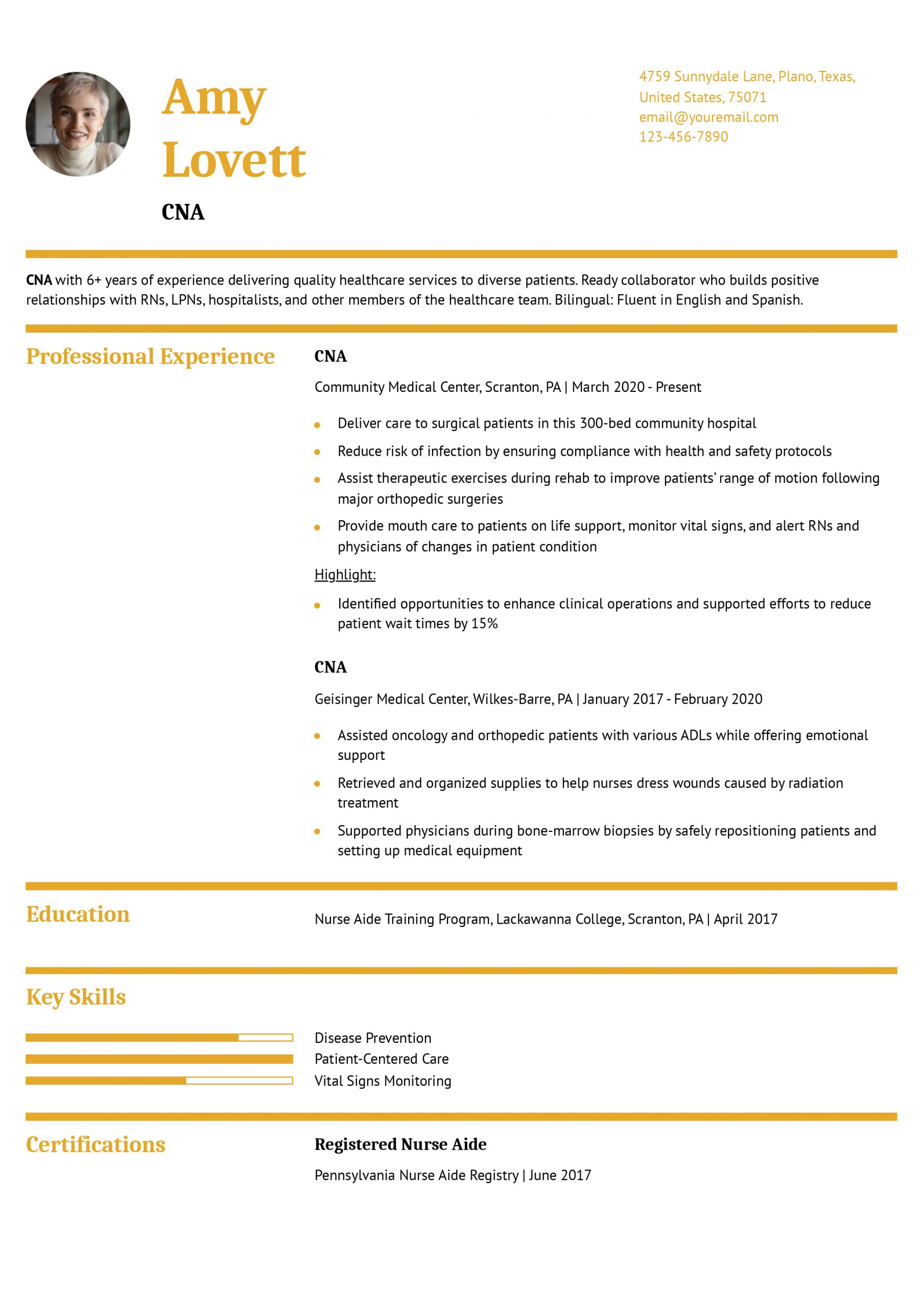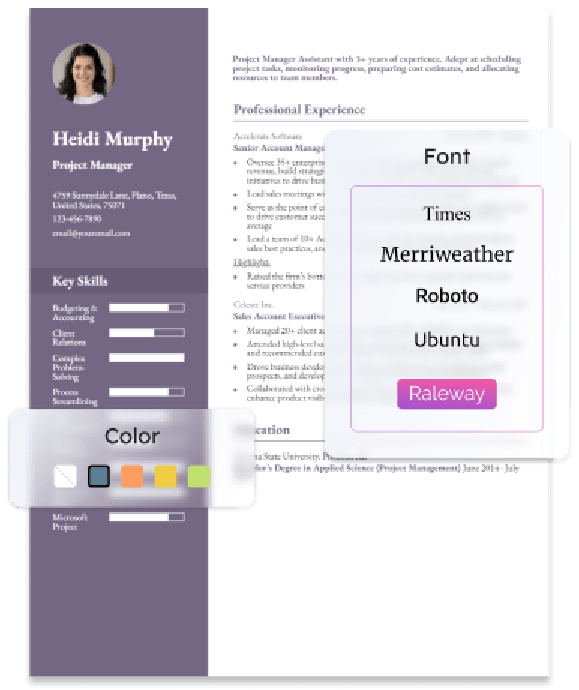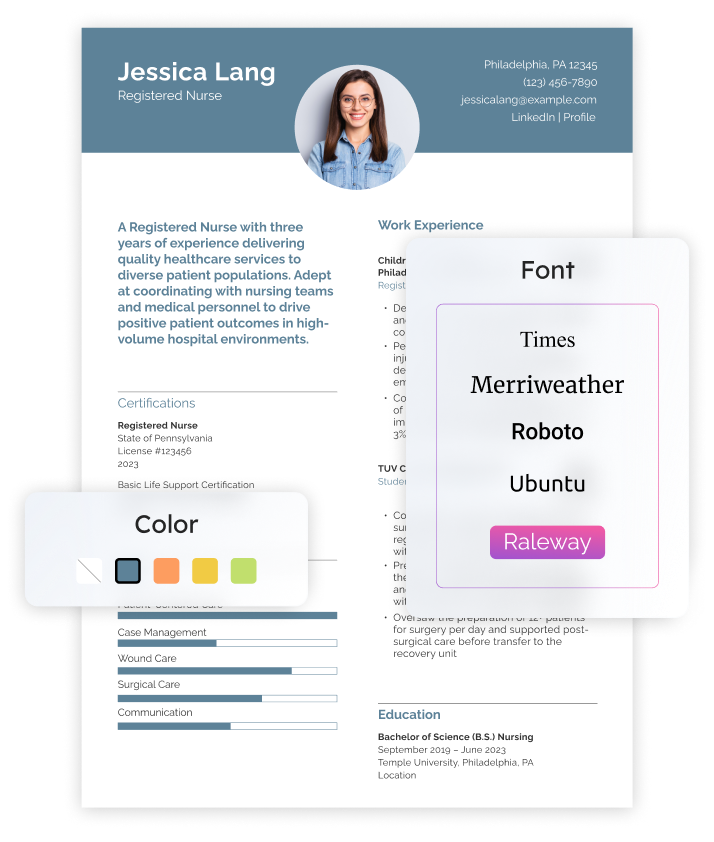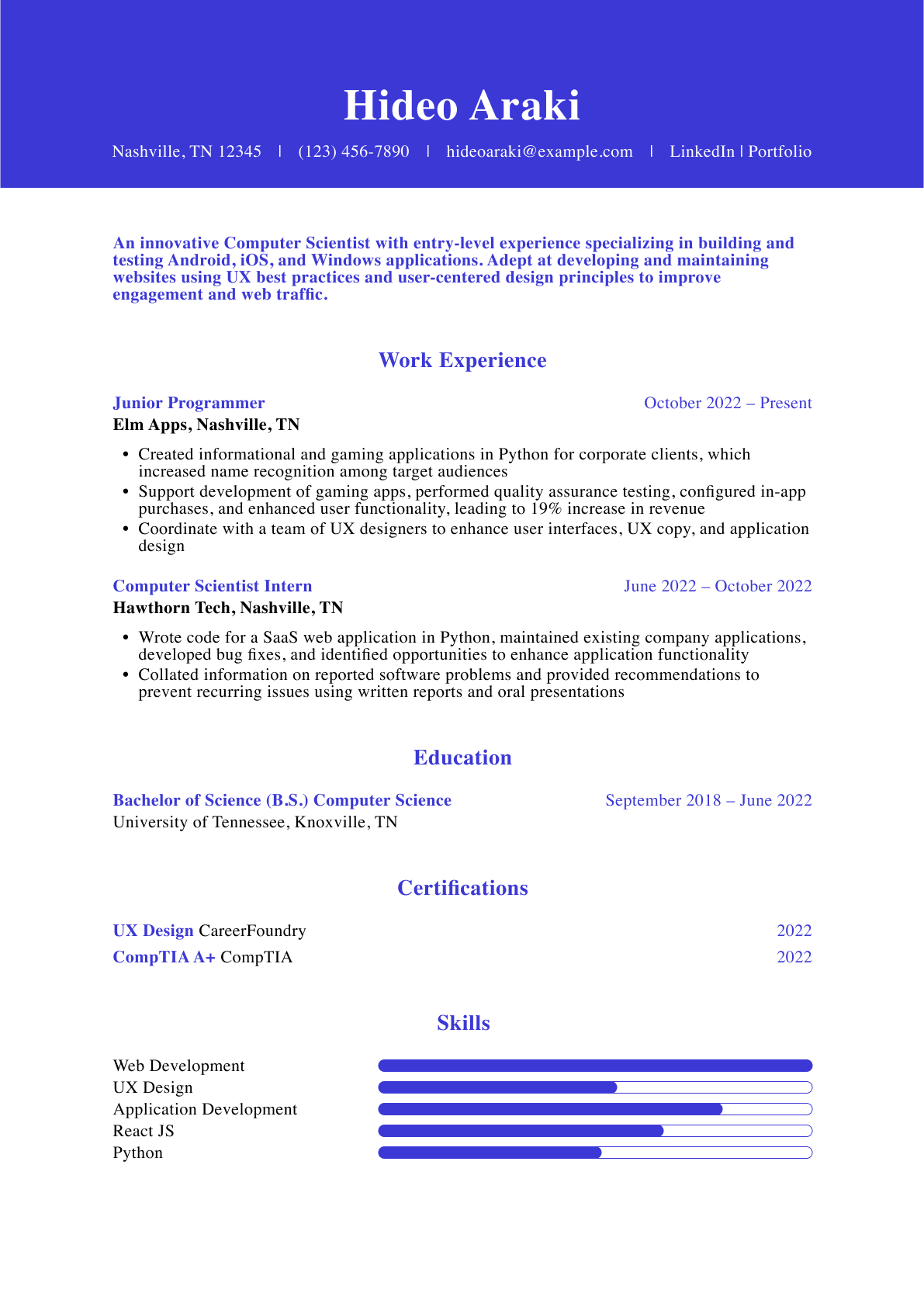You can write a strong certified nursing assistant (CNA) resume by showing how you keep patients safe and comfortable at a hospital or other health care facility. The tips below will help you capture these skills —like monitoring patients’ pulse and blood pressure or helping nursing staff provide wound care — in each section of your resume so it gets you interviews for your next CNA job.
Most Popular Certified Nursing Assistant Resumes
Hospital CNA Resume
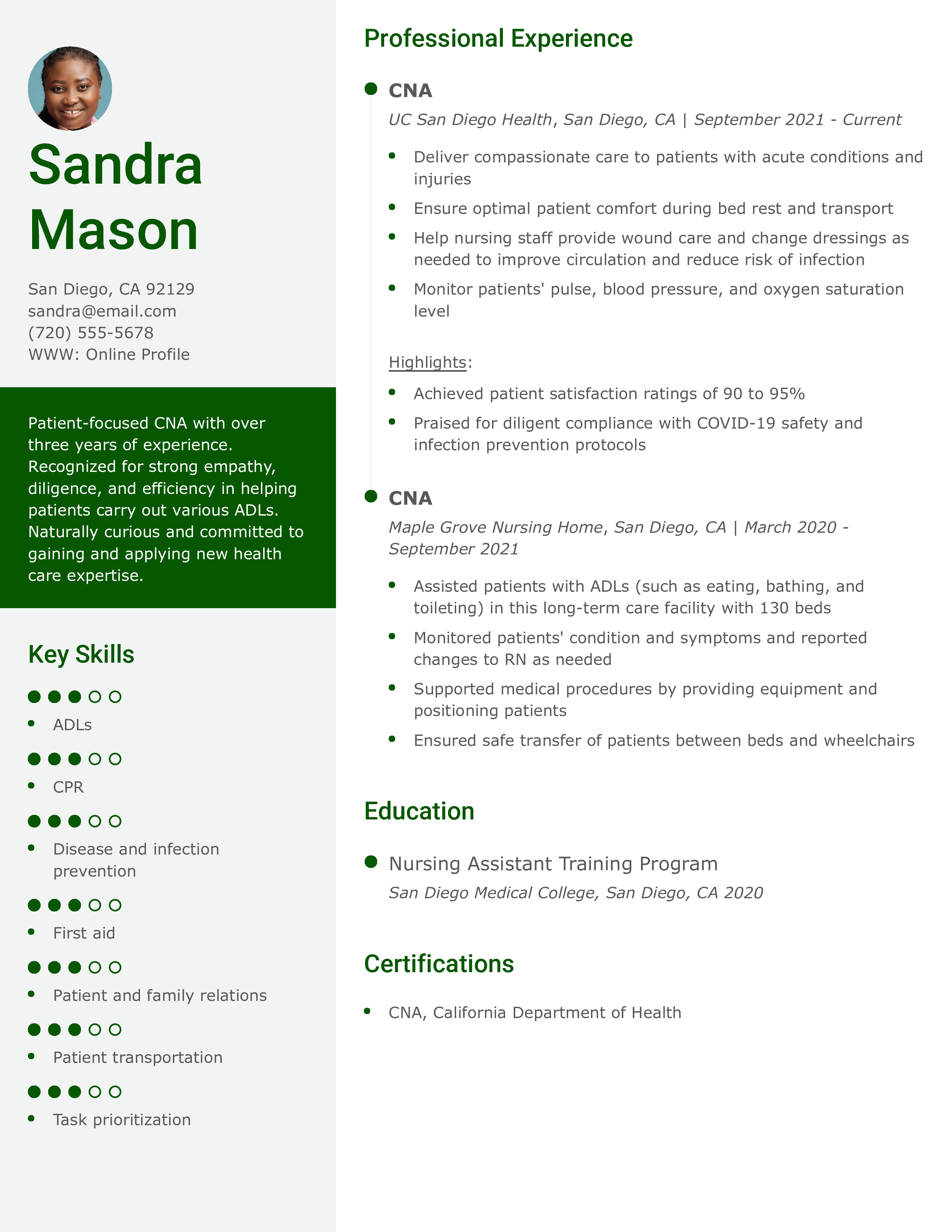
Why this resume is strong:
This resume highlights over three years of experience in patient care within both a hospital and nursing home setting, demonstrating the candidate's ability to handle a variety of acute conditions. It emphasizes key skills such as ADLs, vital sign monitoring, and infection prevention, which are critical in health care environments. The resume also highlights strong patient outcomes, such as achieving a 90% to 95% patient satisfaction rating, showcasing the candidate's competence in providing compassionate and effective care.
For more advice on showcasing skills, visit resume skills.
Mid-Career CNA Resume
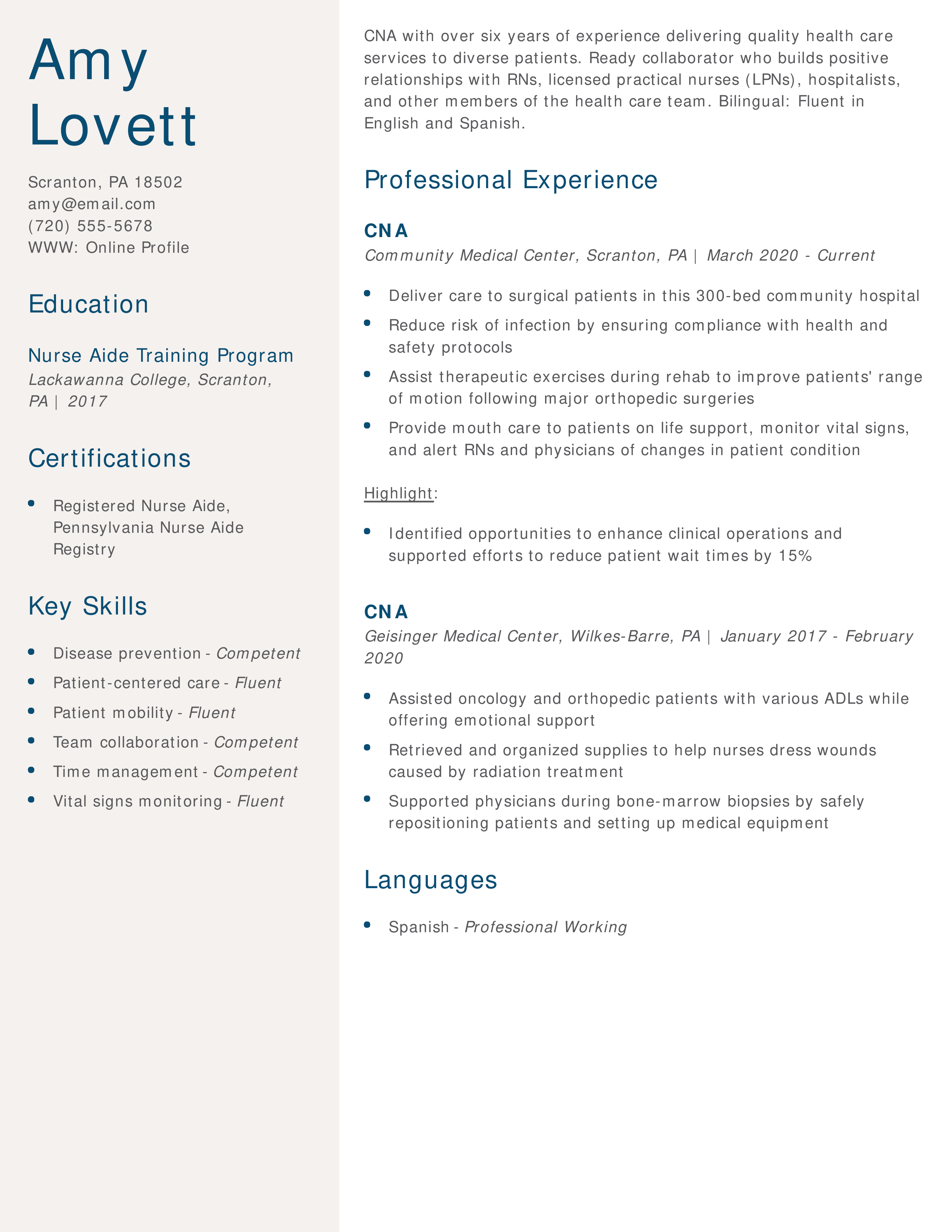
Why this resume is strong:
With six years of experience, this resume emphasizes the candidate's ability to work in a team-based health care environment, particularly within a surgical setting. The mention of bilingual skills (English and Spanish) enhances the candidate’s value in diverse patient care environments. The resume also highlights process improvements, such as reducing patient wait times by 15%, which showcases an ability to enhance clinical efficiency. Additionally, it provides a strong sense of collaboration with nurses and other health care providers.
For guidance on listing skills effectively, check out technical skills for resume.
Lead CNA Resume
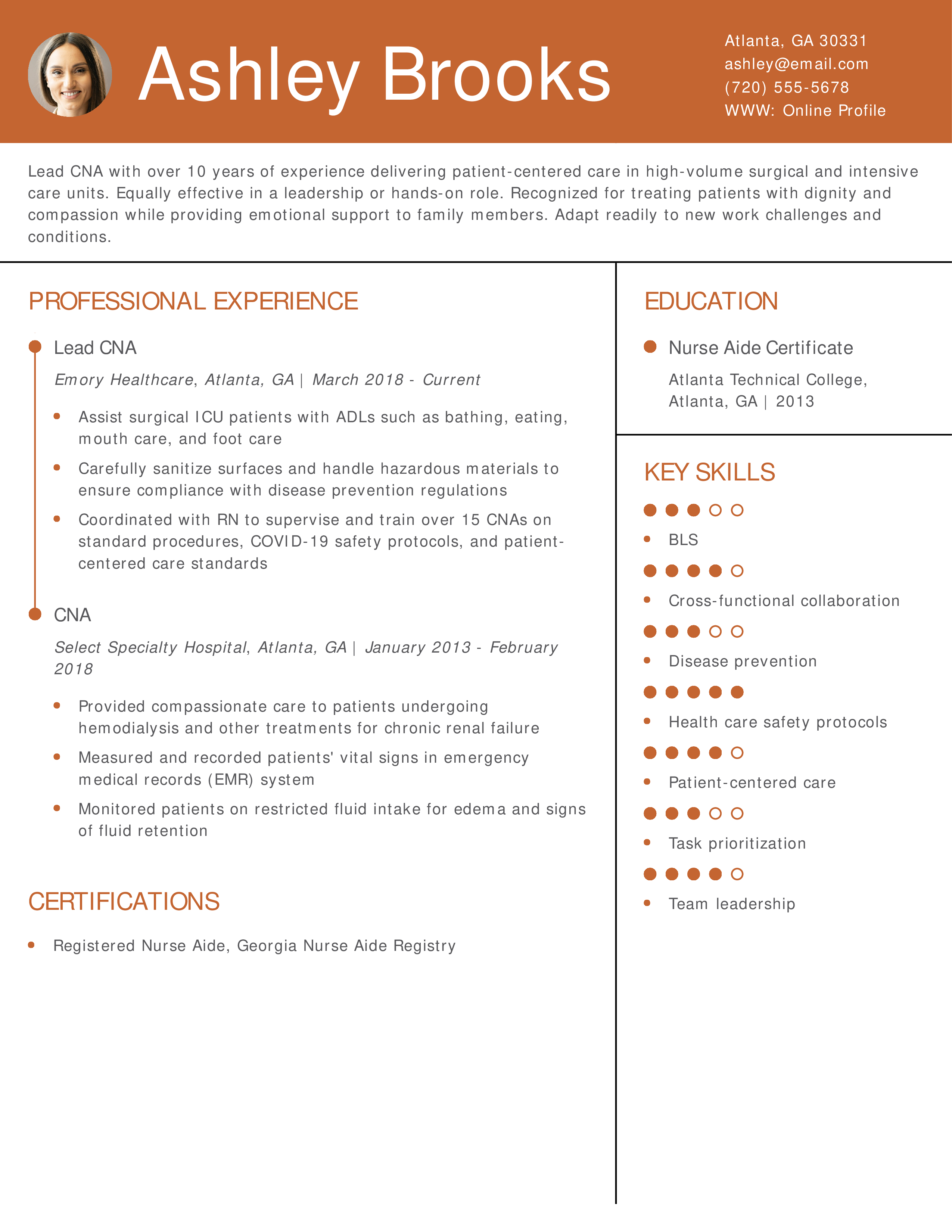
Why this resume is strong:
This resume showcases leadership skills in a high-pressure setting, such as surgical and ICU units. It highlights over 10 years of experience, making the candidate well-suited for leadership or supervisory roles. The resume stands out by emphasizing the candidate’s experience in training over 15 CNAs and ensuring compliance with health care safety protocols, which demonstrates a commitment to quality and safety in patient care. It also focuses on cross-functional collaboration, a key strength in managing patient care teams.
For insights on crafting leadership-driven resumes, check out resume outline examples.
CNA Caregiver Resume
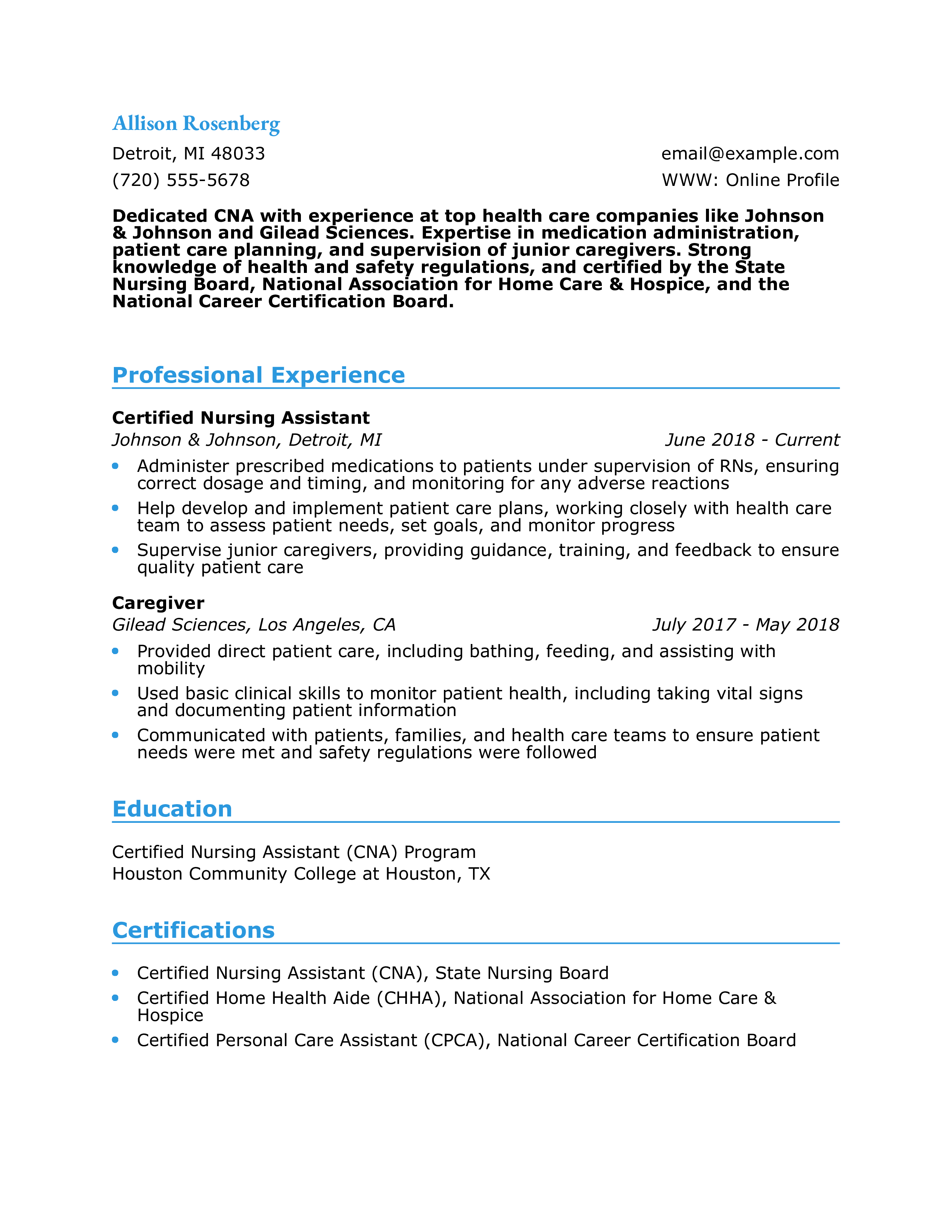
Why this resume is strong:
This resume is tailored to emphasize experience in both patient care planning and supervision of junior caregivers. The candidate's work at top health care companies such as Johnson & Johnson and Gilead Sciences adds prestige to the resume. The ability to handle medication administration, along with knowledge of health and safety regulations, positions the candidate as both detail-oriented and compliant with industry standards. The inclusion of certifications such as Certified Home Health Aide (CHHA) further demonstrates the candidate's competence in both home health and nursing environments. For tips on adding certifications, visit how to list certifications on a resume.
CNA Supervisor Resume
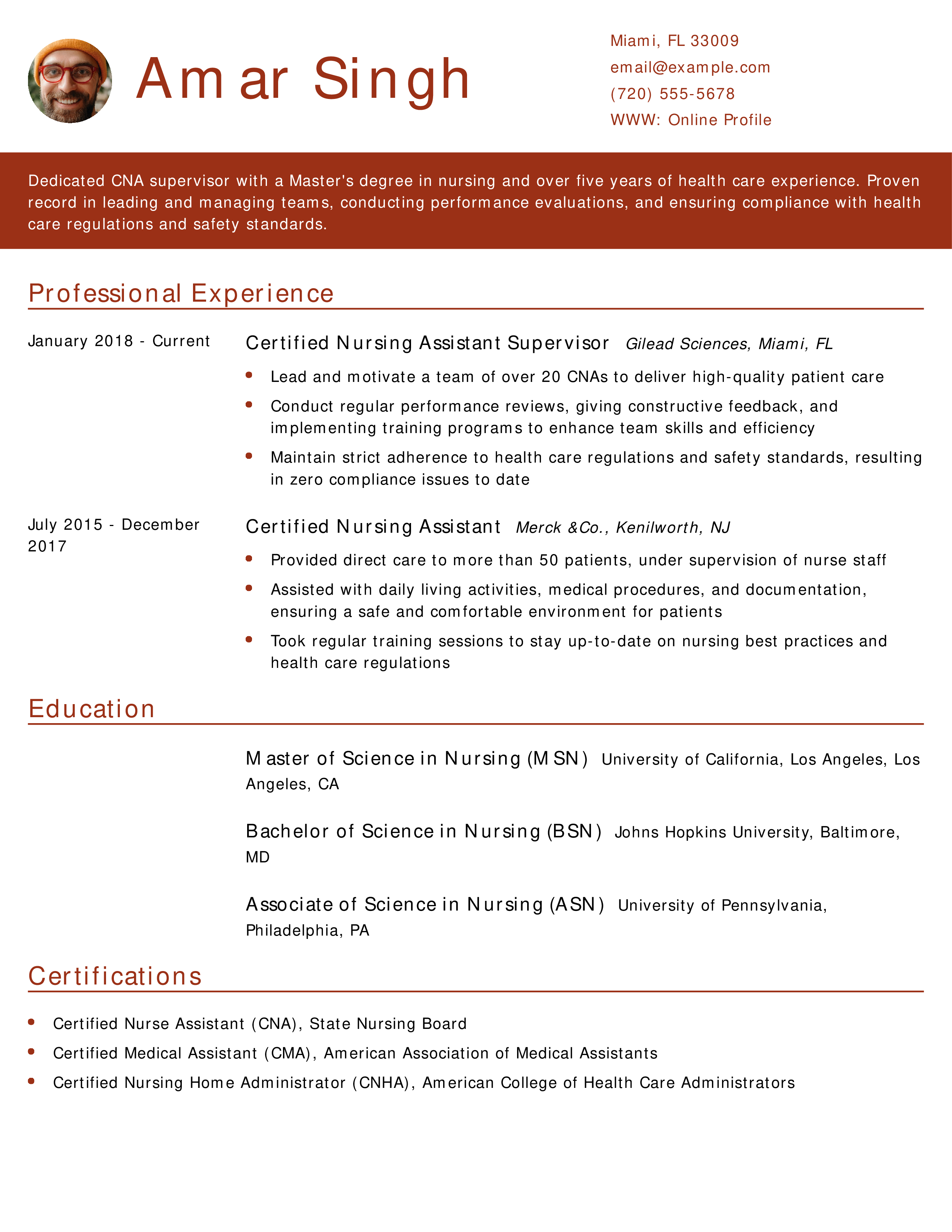
Why this resume is strong:
This resume highlights the candidate's leadership as a CNA supervisor, showing experience in managing over 20 CNAs and ensuring compliance with health care regulations. With a Master’s degree in nursing, this candidate stands out due to their advanced education, which adds credibility and positions them for higher-level management roles. The ability to conduct performance reviews and implement training programs showcases skills in staff development and operational efficiency.
For insights into managing your resume layout, check out best resume formats.
Home Health CNA Resume

Why this resume is strong:
This resume focuses on home health care, highlighting over three years of experience in assisting with daily activities and medication administration in both home and hospital settings. The resume emphasizes key achievements such as improving care coordination by 25%, demonstrating the candidate’s ability to enhance patient outcomes. Additionally, the resume outlines relevant certifications, such as Certified Home Health Aide (CHHA), which are critical for home health roles.
For more on how to highlight home health care skills, check out how to list certifications on a resume.
Hospice CNA Resume
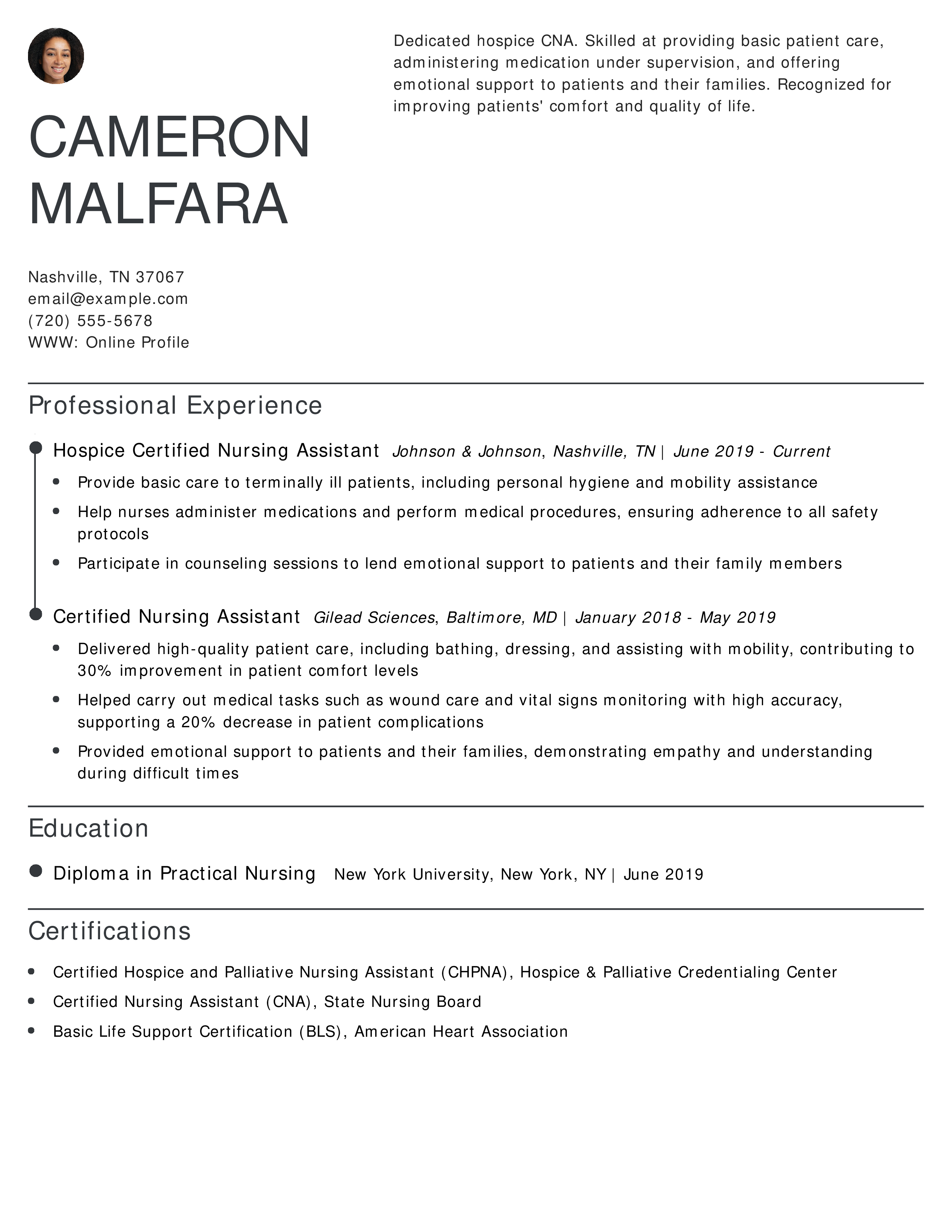
Why this resume is strong:
This resume emphasizes experience in hospice care, focusing on the ability to provide both medical care and emotional support to terminally ill patients and their families. The candidate’s certifications in hospice and palliative care further enhance their qualifications for specialized roles. The resume also highlights the ability to reduce patient complications by 20% through accurate wound care and vital sign monitoring, showing a dedication to improving patient comfort.
For advice on crafting specialized resumes, check out how to list relevant coursework on resume.
Caregiver Resume
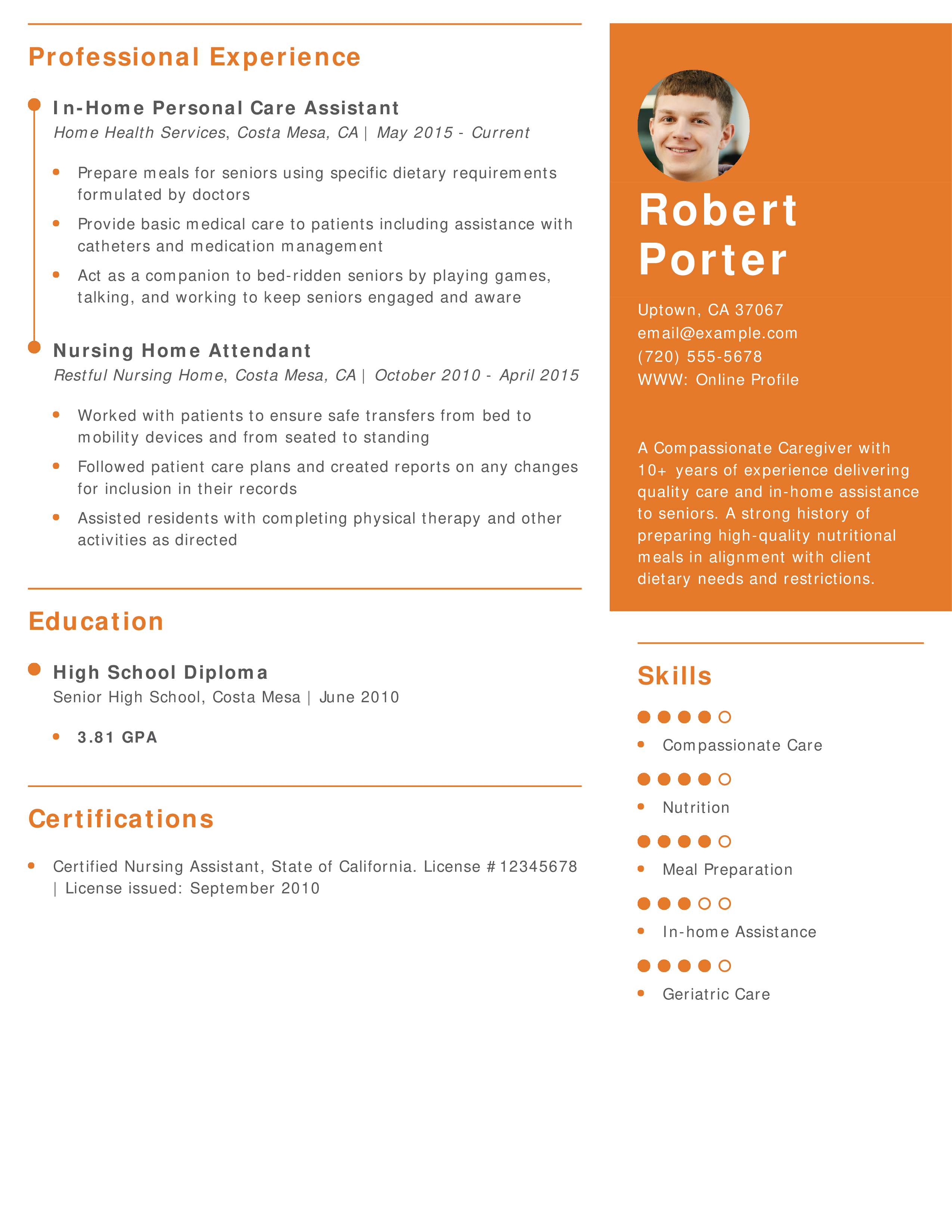
Why this resume is strong:
With over 10 years of experience in senior care, this resume showcases expertise in preparing nutritional meals and providing medical care. The focus on compassionate care, combined with a strong history of geriatric care, makes this candidate highly appealing for in-home and senior care roles. The resume also highlights meal preparation and adherence to specific dietary requirements, which is crucial for senior patients with dietary restrictions.
For more on showcasing caregiver skills, check out resume skills.
Nurse Resume
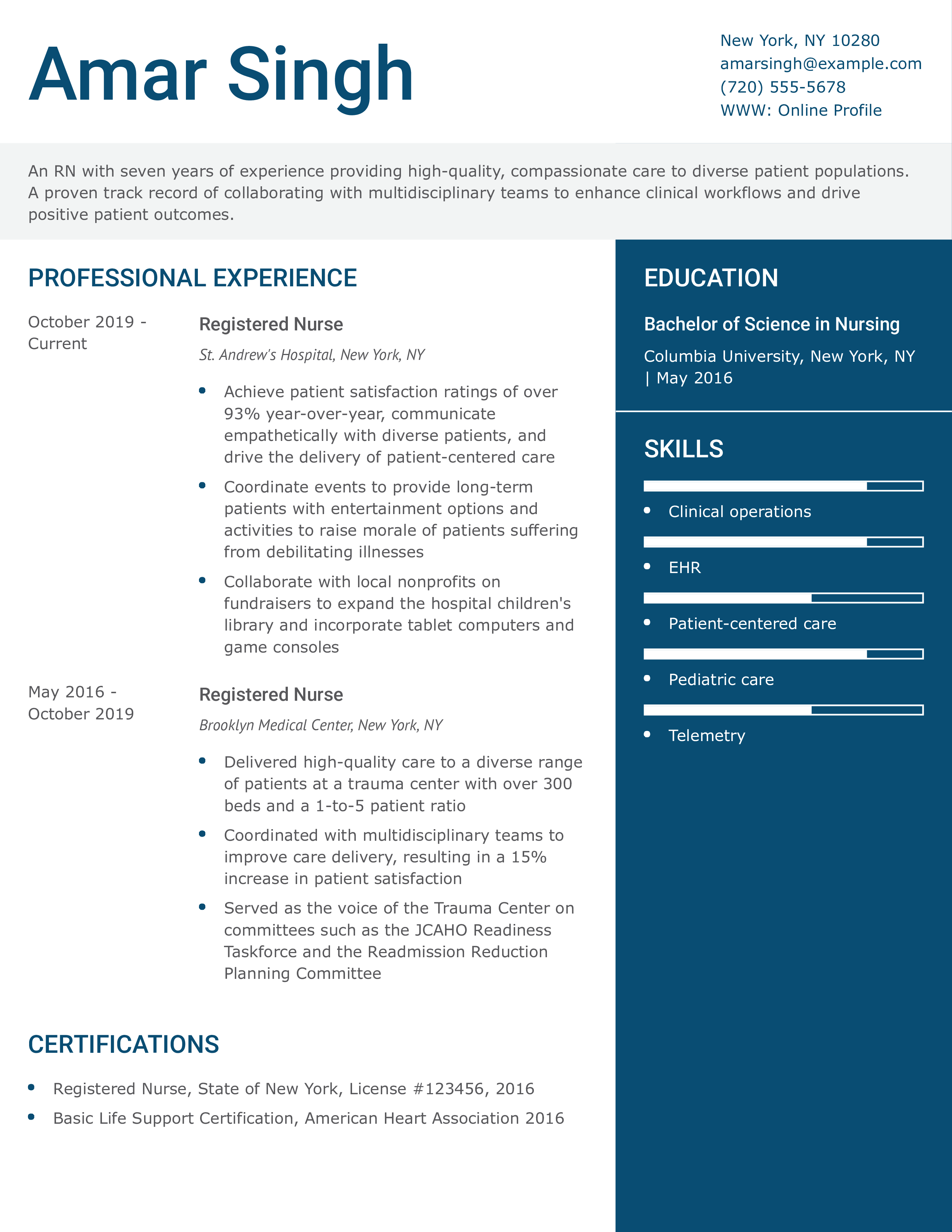
Why this resume is strong:
This resume stands out due to its emphasis on patient satisfaction, achieving over 93% patient satisfaction ratings year-over-year. The candidate also demonstrates success in organizing patient morale-boosting events, which shows a holistic approach to patient care. With experience in trauma centers and multidisciplinary team collaboration, the resume highlights both clinical expertise and strong teamwork abilities. The inclusion of committee work and hospital initiatives further demonstrates leadership in driving positive patient outcomes.
For more advice on formatting, check out best resume formats. .
Beginner CNA Resume
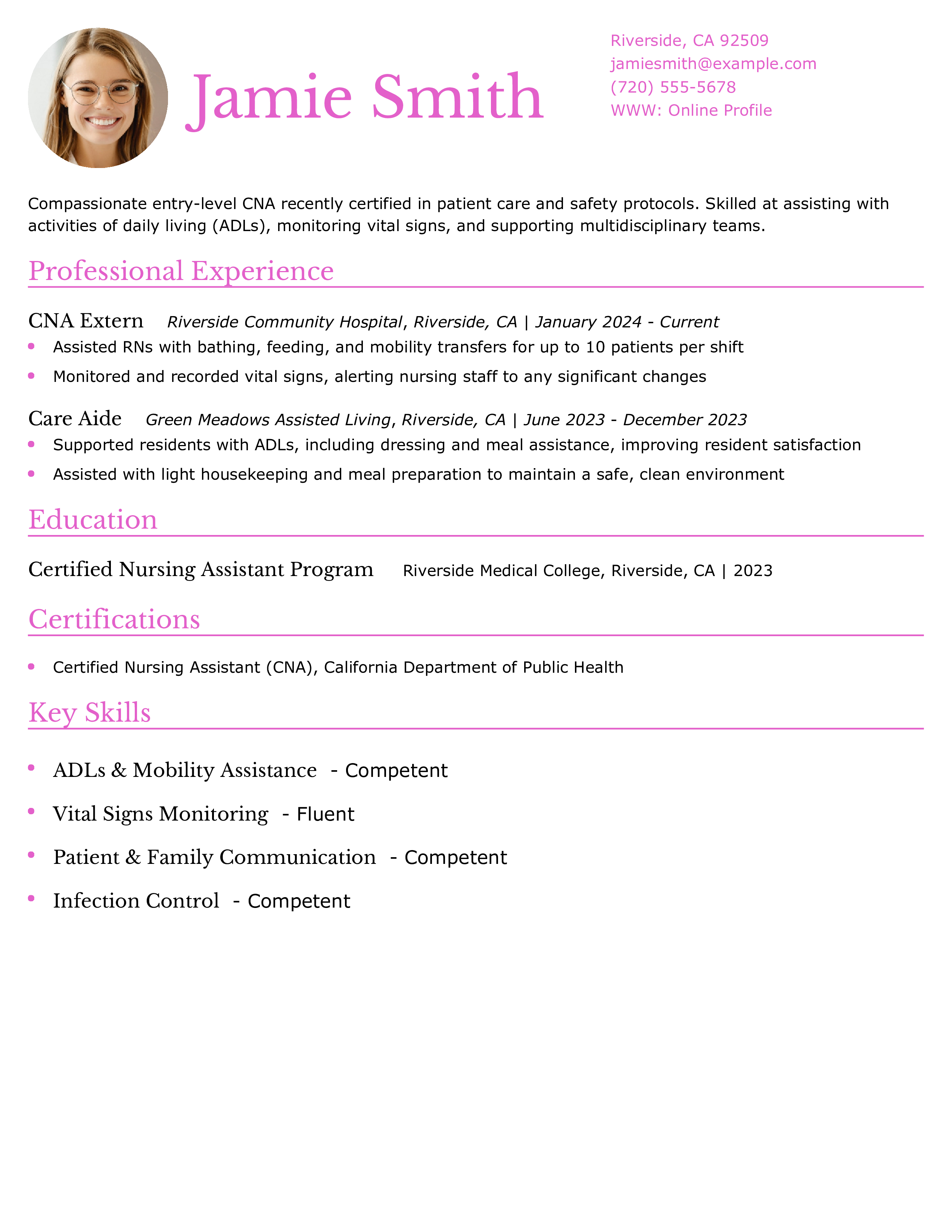
Why this resume is strong:
This resume highlights the candidate’s recent hands-on externship and care aide experience. It demonstrates practical skills in patient support and vital-sign monitoring. The clear focus on ADLs and safety protocols shows readiness for an entry-level role.
Key Tips Emphasize your earliest contributions by quantifying tasks to demonstrate impact. For advice on structuring your experience, see Best Resume Formats. .
Inpatient CNA Resume
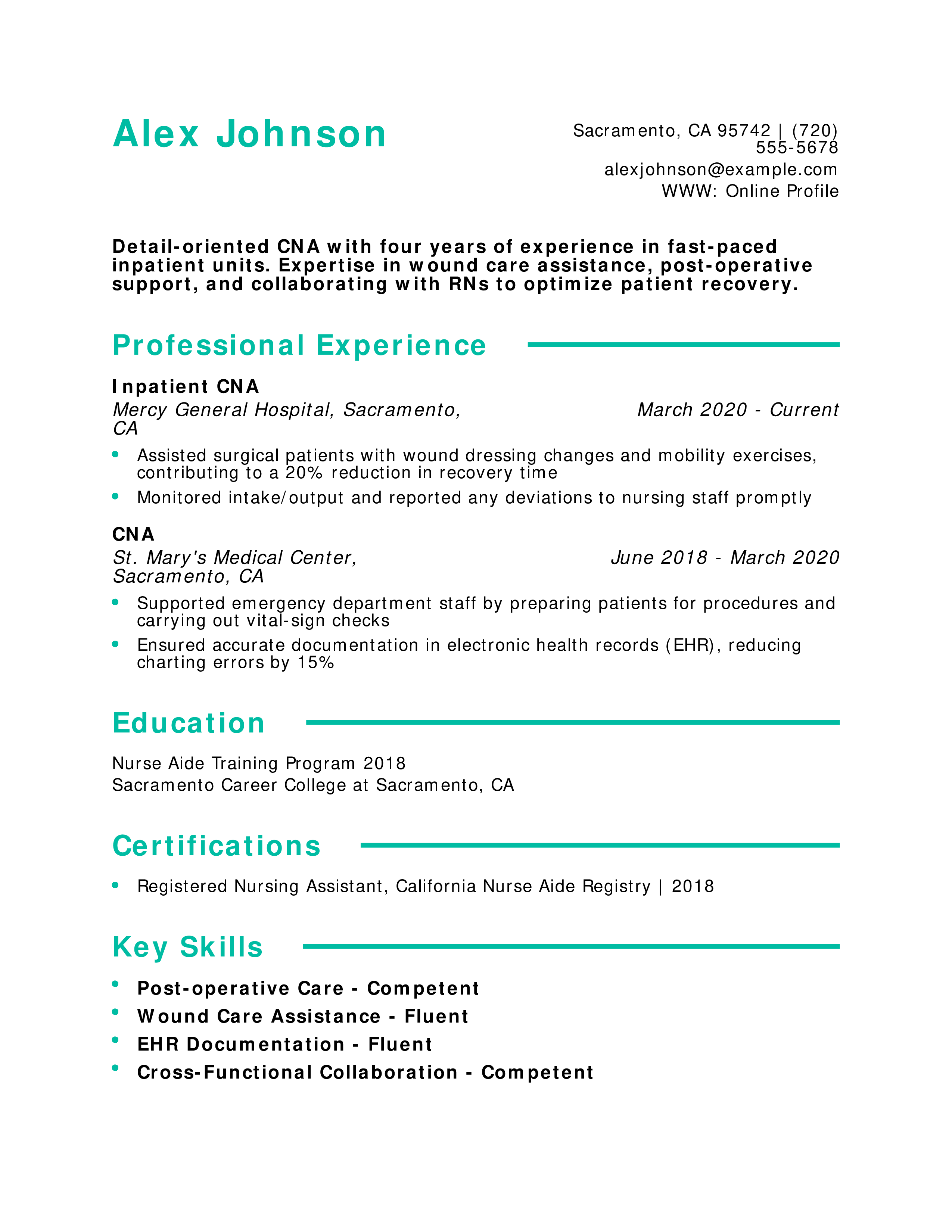
Why this resume is strong:
Alex’s resume emphasizes critical inpatient experience, including wound care and EHR accuracy. Quantifiable improvements—like a 20% reduction in recovery time—demonstrate real impact.
Key Tips Showcase technical proficiencies such as EHR systems to highlight adaptability and precision in documentation. For tips on quantifying your achievements, see Resume Skills. .
Pediatric CNA Resume
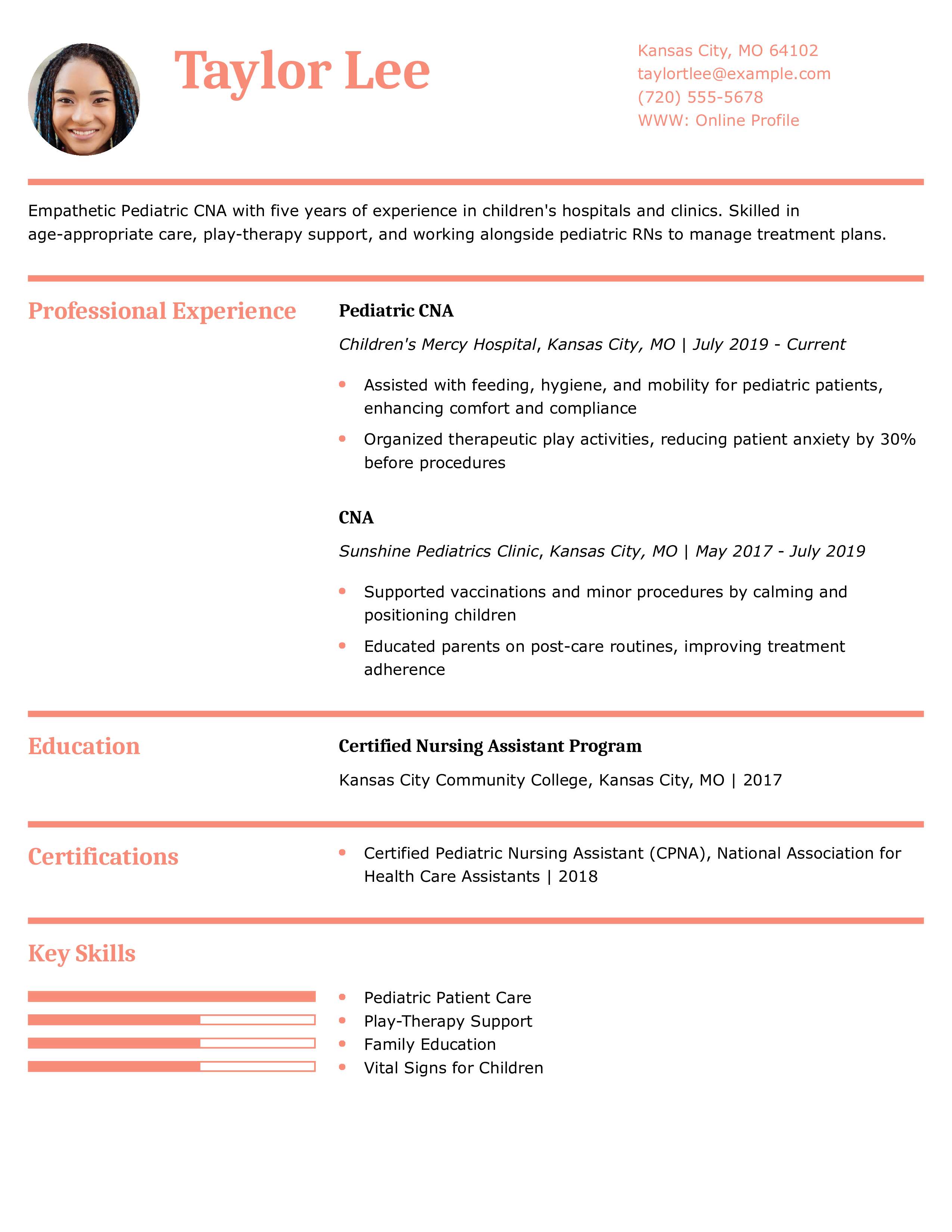
Why this resume is strong:
Taylor’s resume showcases specialized pediatric skills—like play therapy—to ease patient anxiety, backed by measurable outcomes. Family education highlights strong communication abilities.
Key Tips Demonstrate your specialty, such as “reduced patient anxiety by 30%,” to stand out in niche roles. For guidance on highlighting soft skills, see Soft Skills For Your Resume. .
CNA Trainer Resume
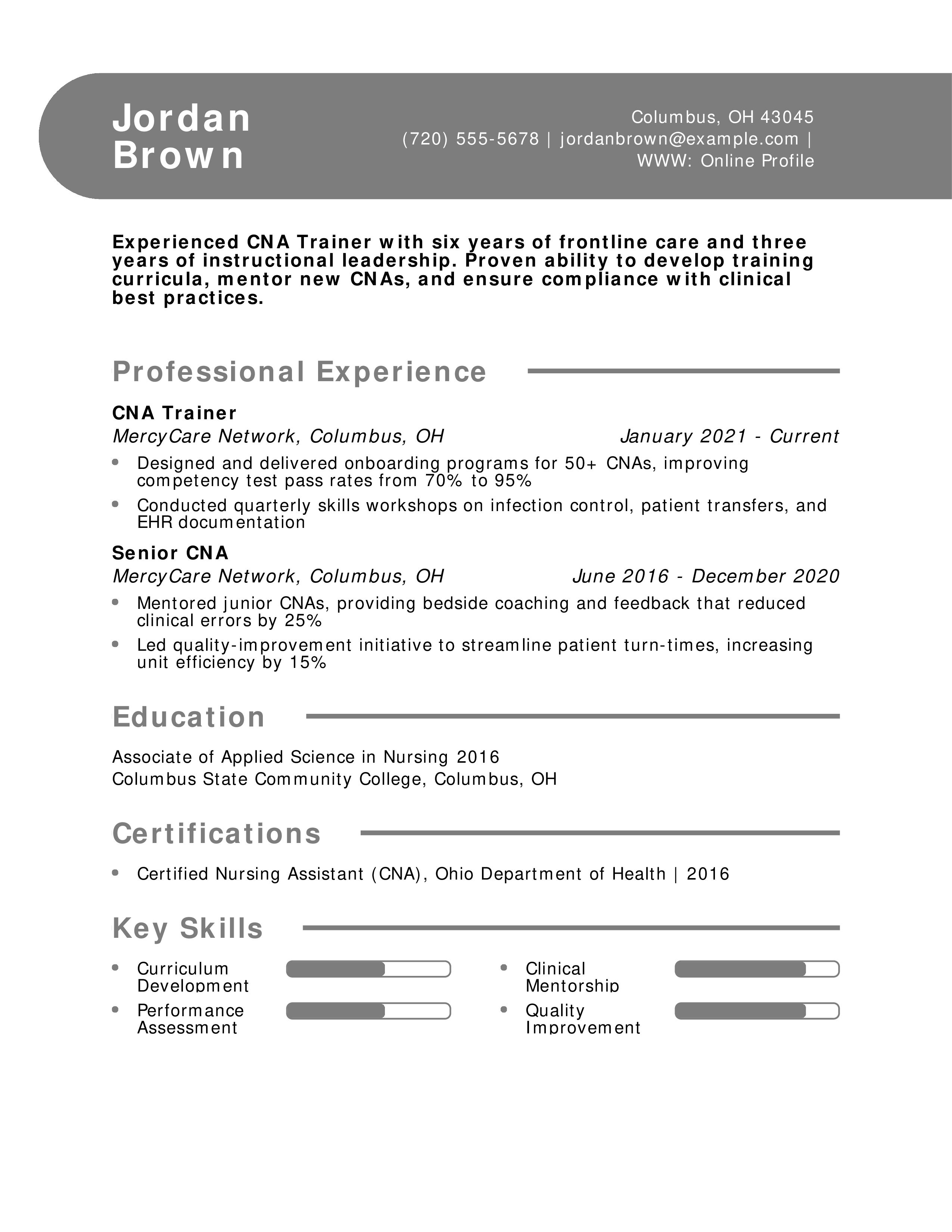
Why this resume is strong:
Jordan’s resume emphasizes both hands-on care expertise and teaching impact, with clear metrics, like raising test pass rates to 95%. Leadership in quality improvement underscores strategic influence.
Key Tips Highlight instructional results by showing before/after metrics to illustrate training impact. For layout ideas, see Best Resume Formats. .
Geriatric CNA Resume
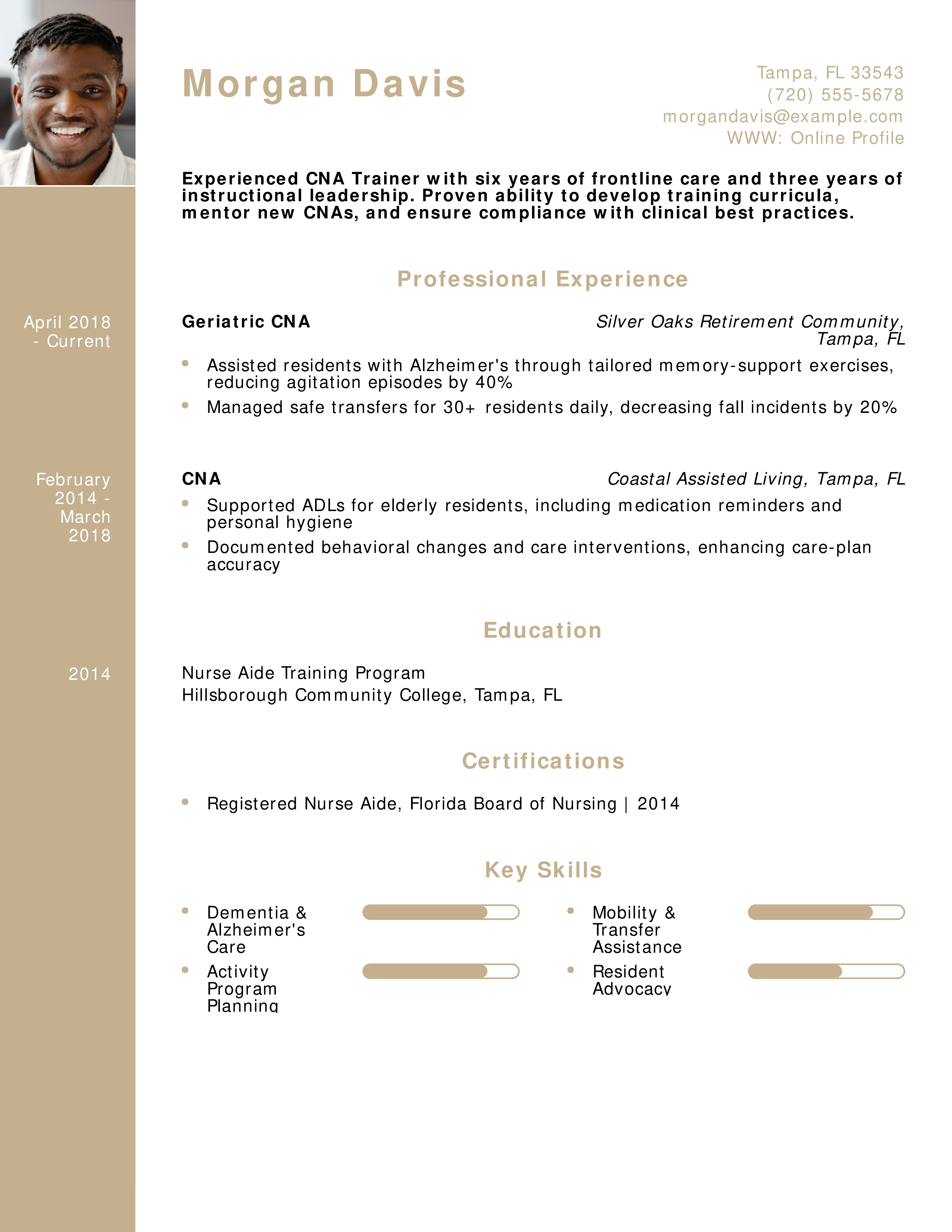
Why this resume is strong:
Morgan’s resume highlights specialized dementia care and quantifies outcomes, like a 40% reduction in agitation. Fall-prevention metrics further demonstrate impact on resident safety.
Key Tips Emphasize your niche expertise, like dementia care, to differentiate yourself. For advice on showcasing technical and soft skills, see Technical Skills for a Resume. .
Dialysis CNA Resume
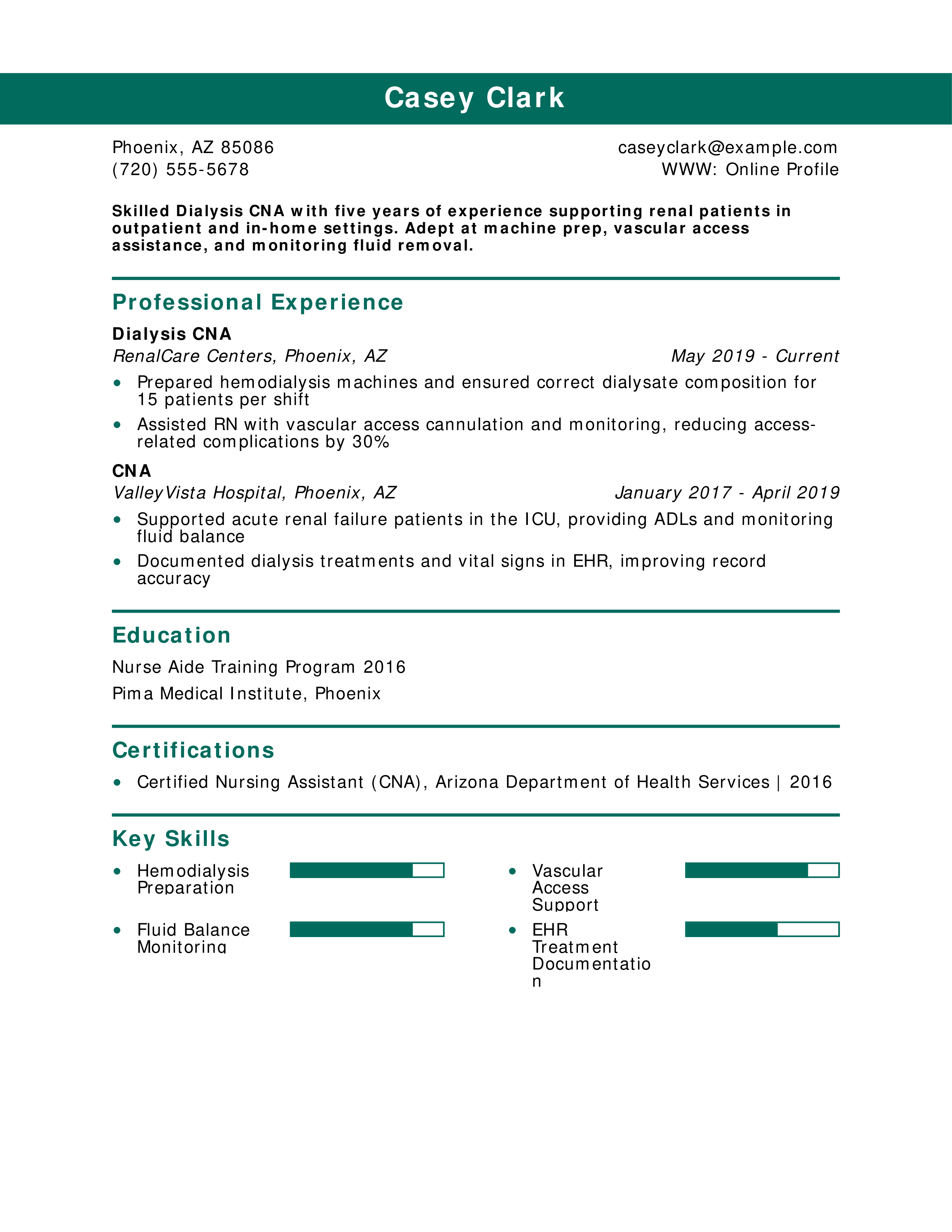
Why this resume is strong:
Casey’s resume focuses on specialized dialysis care, with metrics like a 30% reduction in complications. The blend of outpatient and ICU experience demonstrates versatility.
Key Tips Spotlight your specialized skills, such as hemodialysis preparation, to stand out in niche roles. For guidance on structuring your resume, see Best Resume Formats. .
Rehabilitation Unit CNA Resume
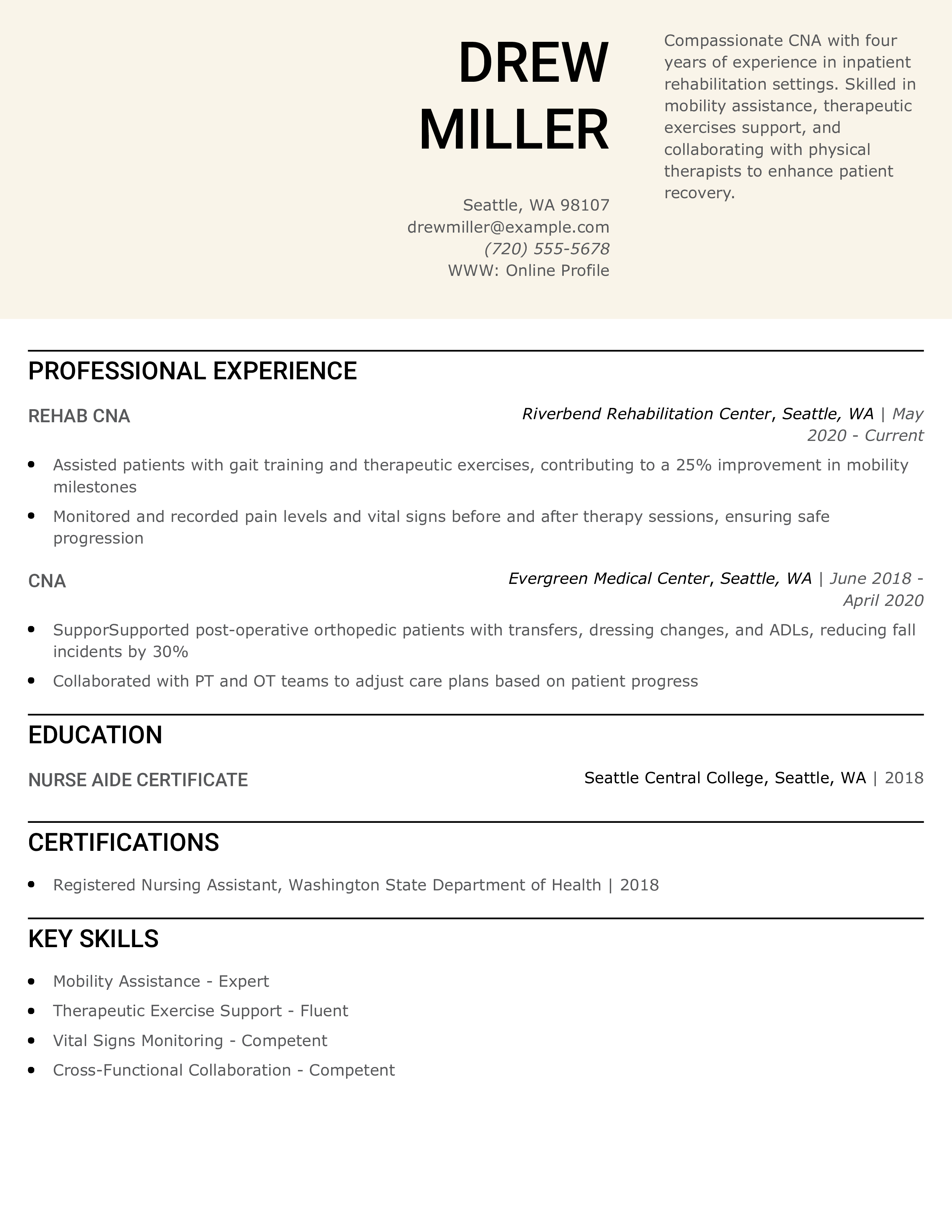
Why this resume is strong:
Drew’s resume highlights measurable rehab outcomes—like a 25% mobility improvement—and strong teamwork with therapy staff. The focus on patient safety metrics further demonstrates clinical competence.
Emphasize quantifiable therapy outcomes to showcase your impact on patient recovery. For more on structuring clinical achievements, see Best Resume Formats. .
Operating Room CNA Resume
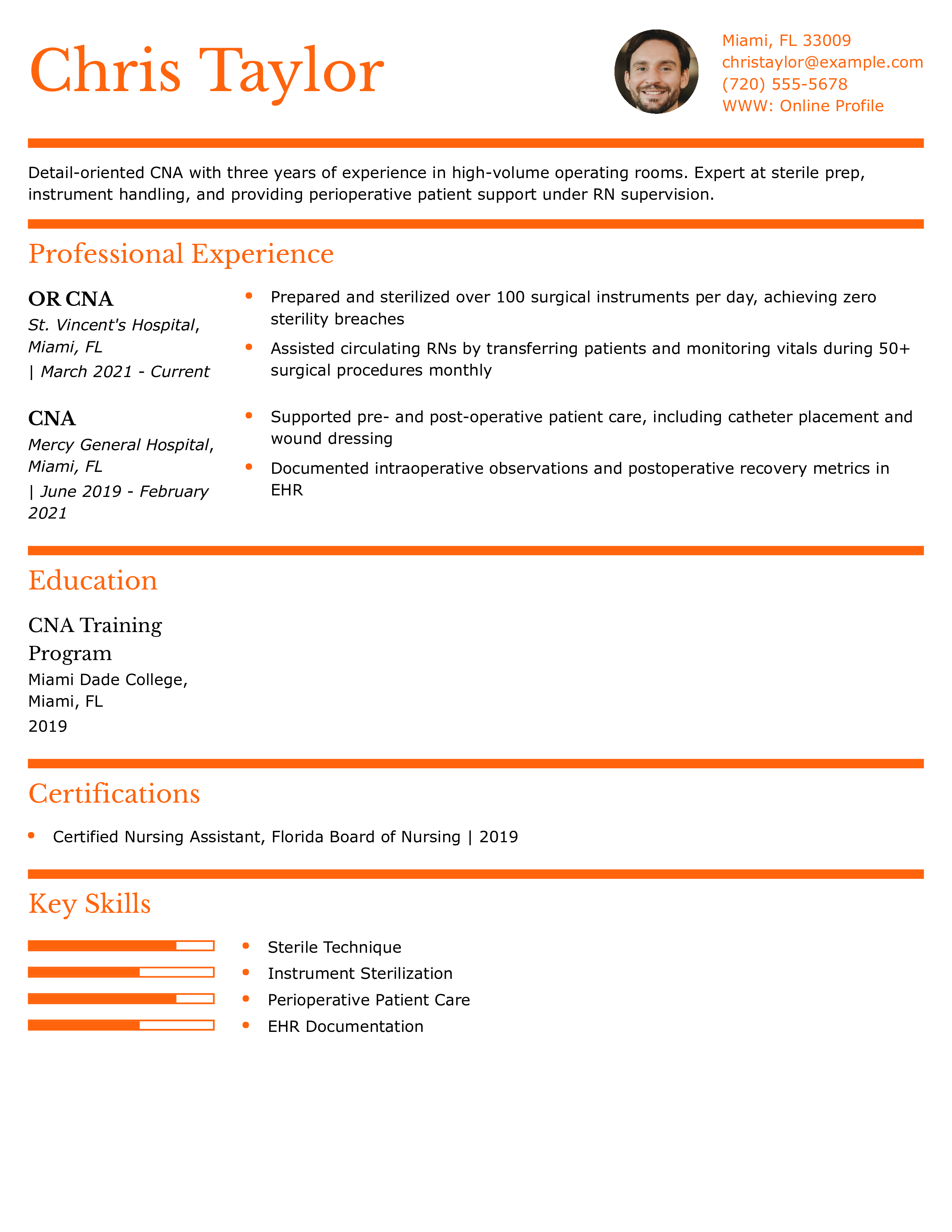
Why this resume is strong:
Chris’s resume emphasizes OR-specific skills, highlighting a flawless sterility record and robust perioperative support. The volume of procedures underscores proven reliability under pressure.
Key Tips Showcase specialized OR competencies, like “zero sterility breaches,” to stand out in surgical roles. For tips on highlighting technical expertise, see Technical Skills for a Resume. .
Behavioral Health CNA Resume
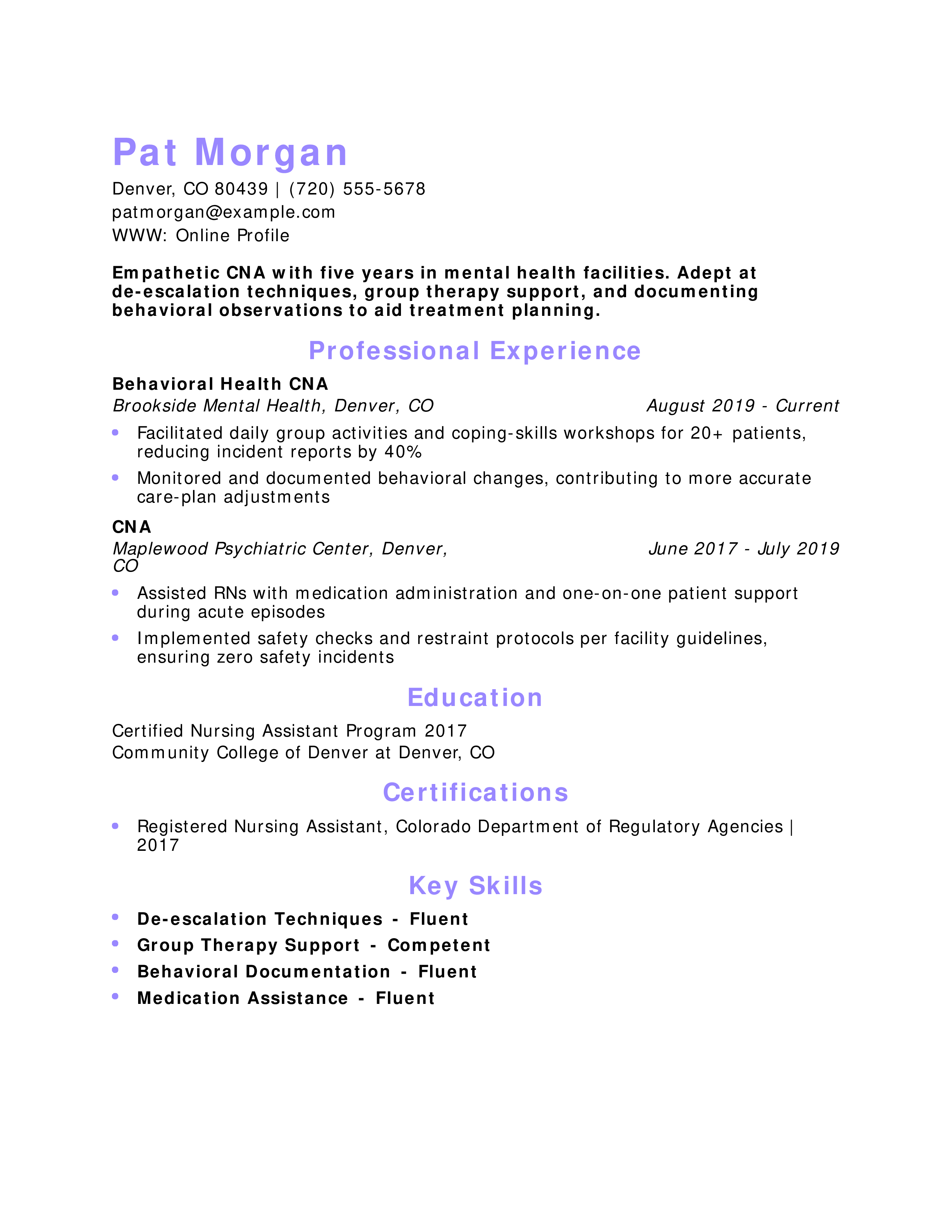
Why this resume is strong:
Pat’s resume underscores specialized behavioral-health contributions—like a 40% drop in incidents—and precise documentation skills. The focus on safety protocols reinforces reliability.
Key Tips Highlight outcomes from your de-escalation and group-support efforts to demonstrate mental health impact.
For guidance on quantifying soft-skill achievements, see Soft Skills for a Resume. .
Telehealth CNA Resume
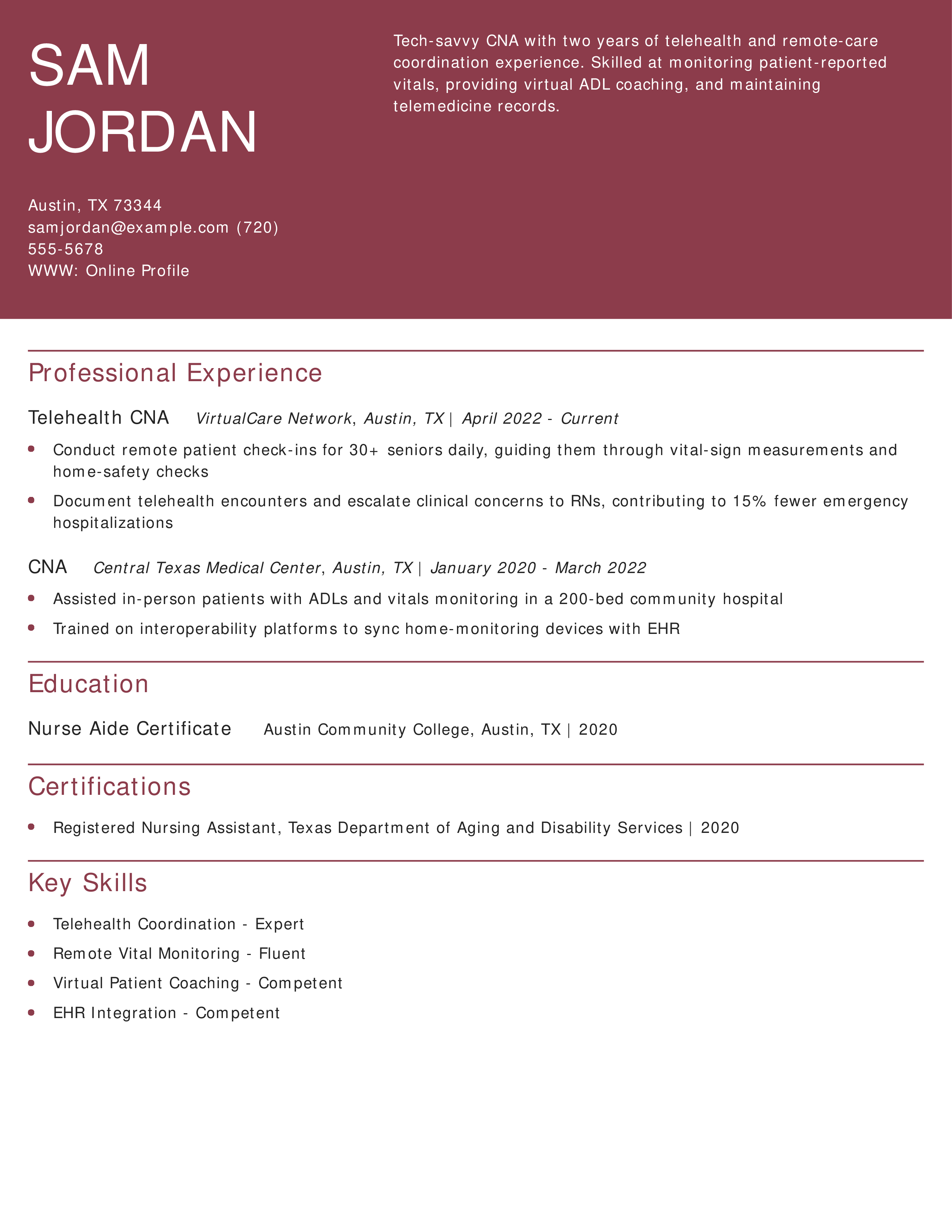
Why this resume is strong:
Sam’s resume showcases remote-care innovation, with metrics like a 15% reduction in hospitalizations via telehealth. Dual in-person and virtual experience underscores adaptability.
Key Tips Quantify your telehealth impact, such as reduced hospitalizations, to illustrate tech-enabled care benefits. For advice on presenting hybrid roles, see Best Resume Formats. .
Travel CNA Resume
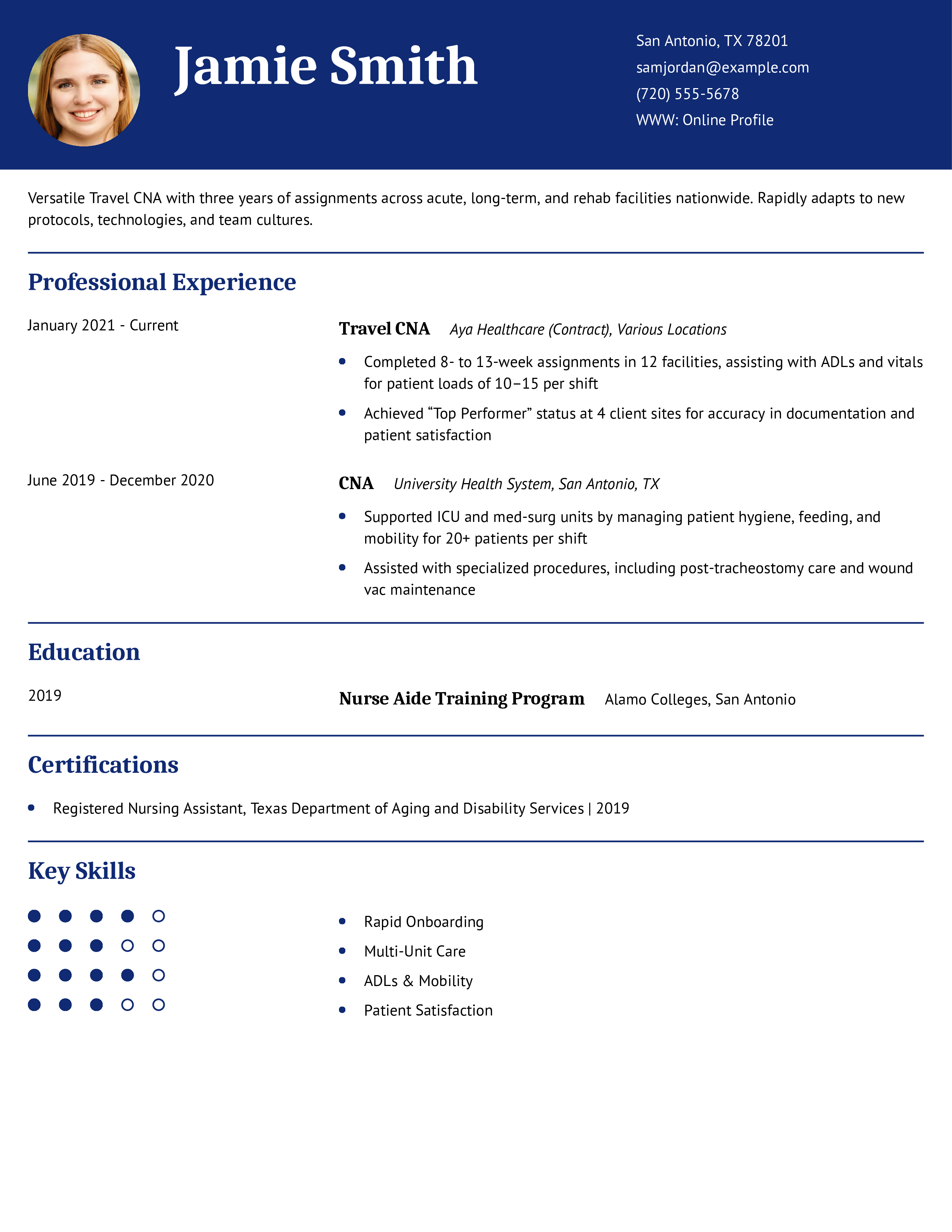
Why this resume is strong:
Jamie’s resume highlights consistent “Top Performer” achievements across multiple travel assignments, demonstrating adaptability and excellence. Diverse unit experience adds credibility.
Key Tips Showcase adaptability metrics—like “Top Performer”—to underscore reliability in new environments.
For more on quantifying performance, see Resume Skills. .
Cardiac Care CNA Resume
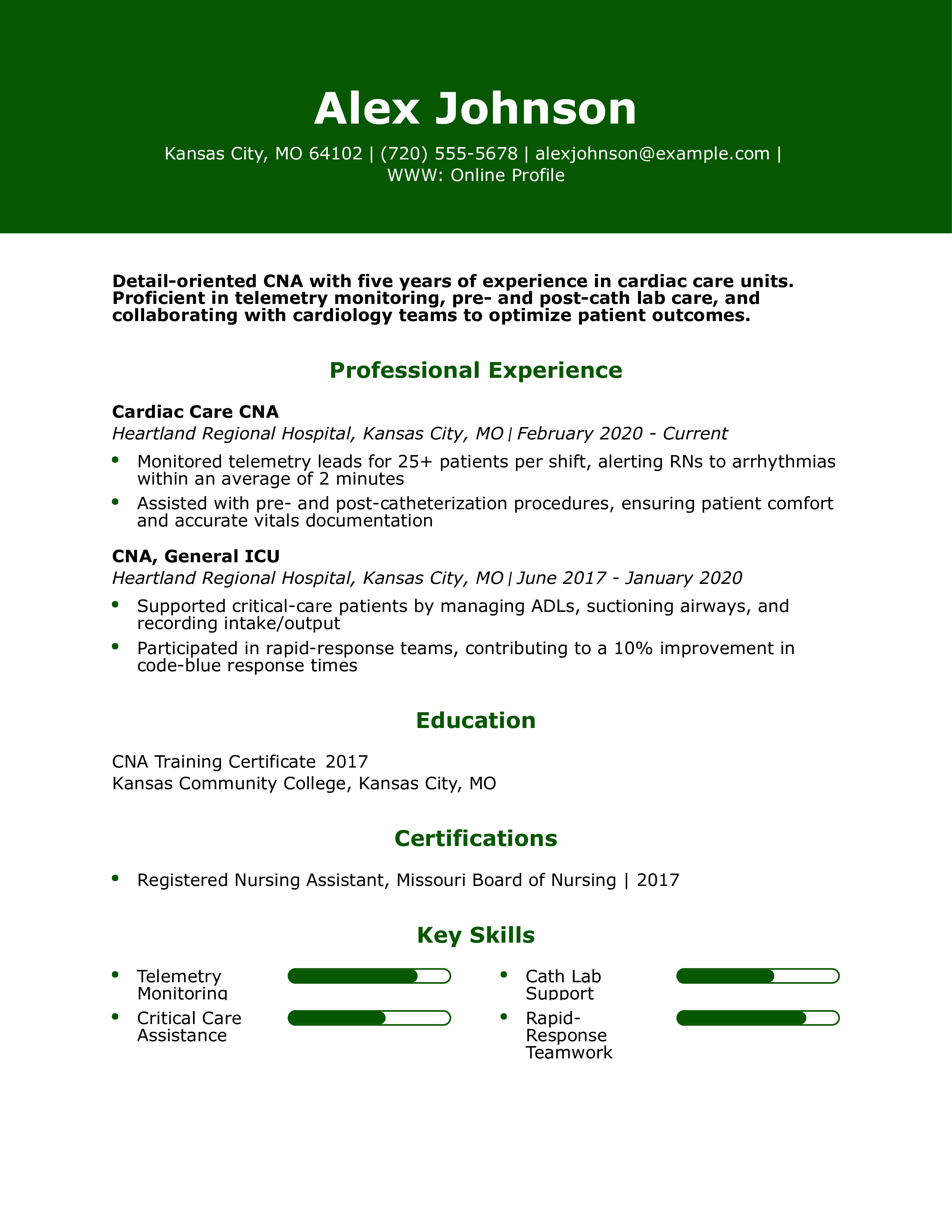
Why this resume is strong:
Alex’s resume emphasizes critical cardiac skills, like rapid arrhythmia alerts, and shows a direct impact on response times. ICU and cath-lab support underscore advanced expertise.
Key Tips Use precise timing metrics, such as “2-minute arrhythmia alerts,” to highlight urgency management skills.
For guidance on structuring technical roles, see Best Resume Formats. .
School Health CNA Resume
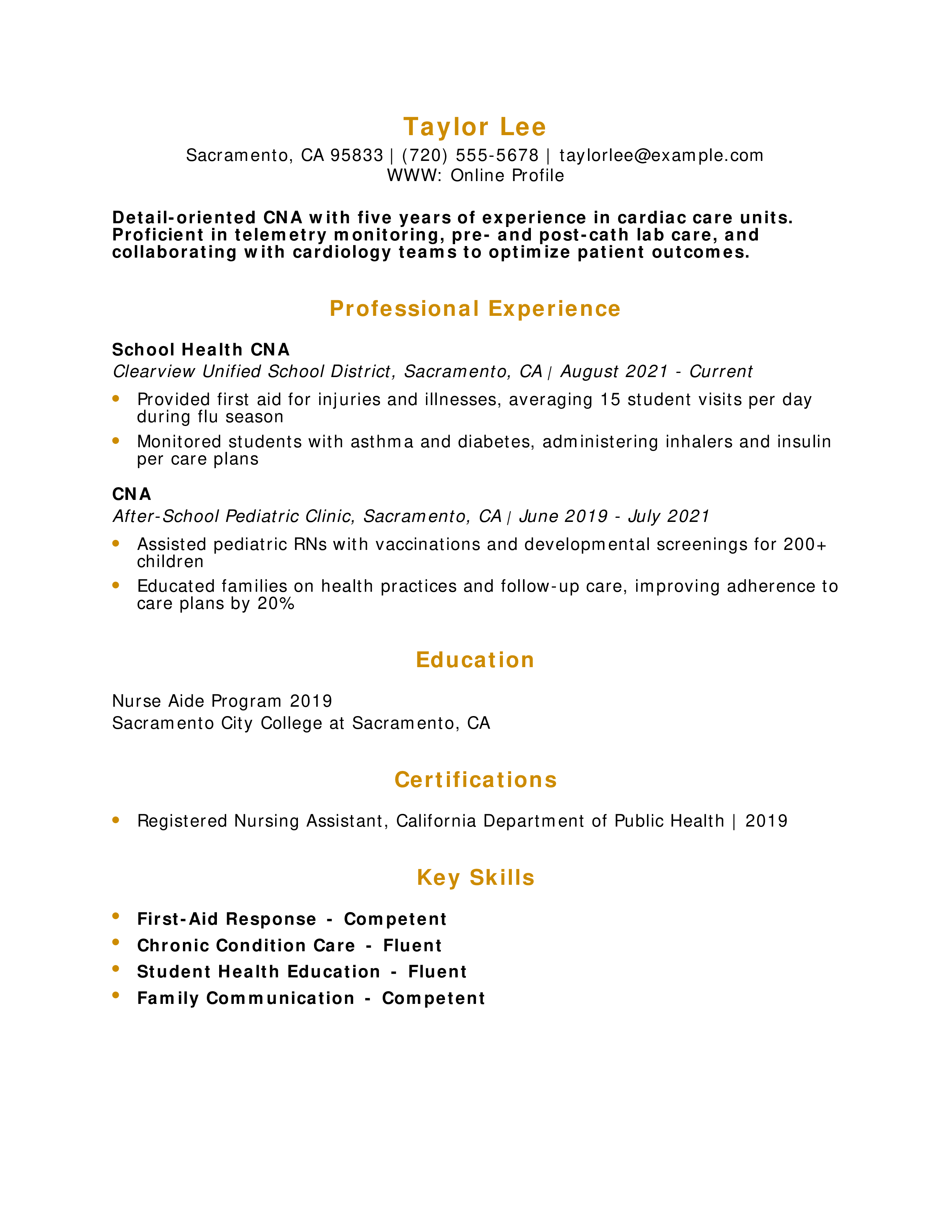
Why this resume is strong:
Taylor’s resume showcases school-clinic volume—15 daily visits—and measurable family-education outcomes. Pediatric and chronic-care skills demonstrate versatility.
Key Tips Quantify your daily caseload to illustrate efficiency under volume. For tips on presenting volume metrics, see Resume Skills. .
Correctional Facility CNA Resume
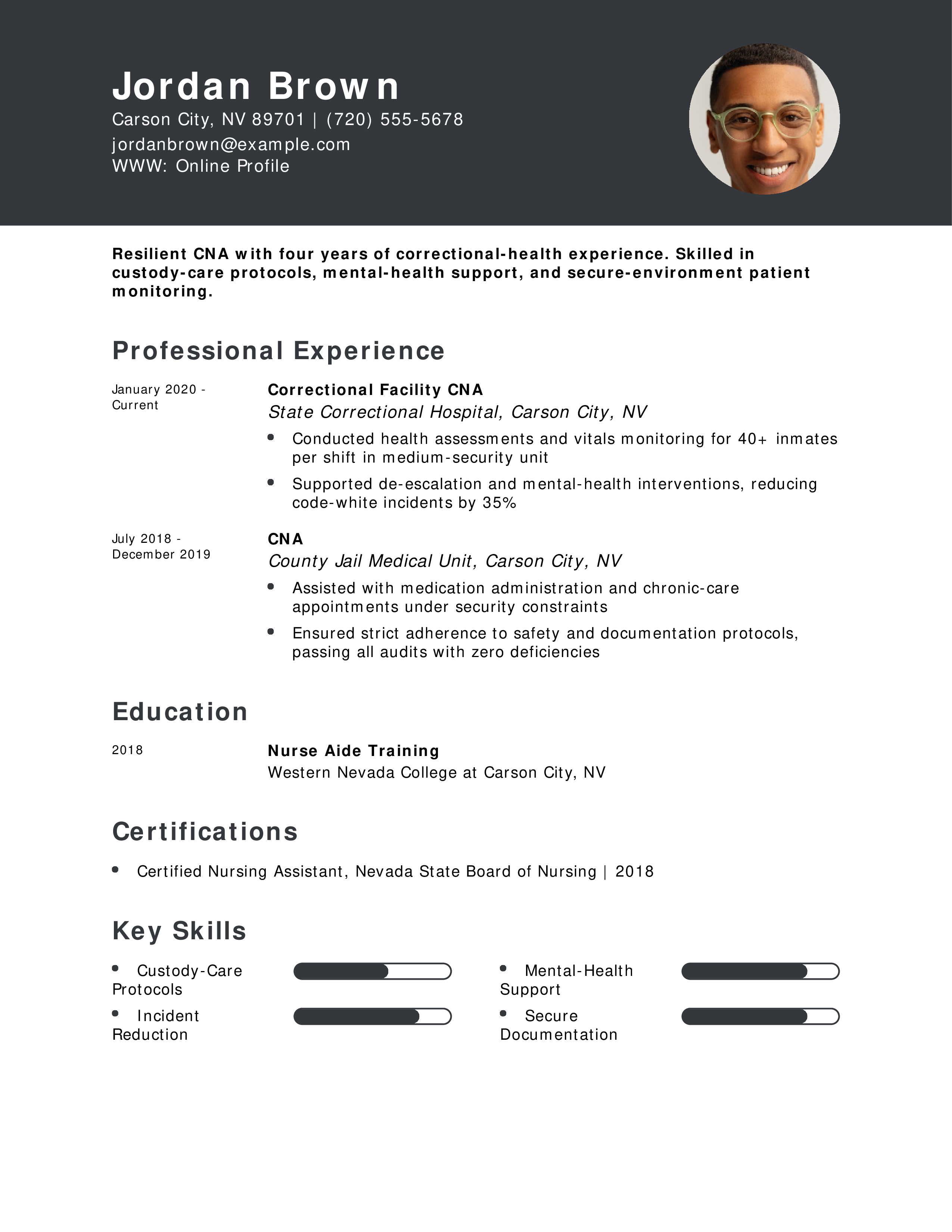
Why this resume is strong:
Jordan’s resume highlights secure-environment achievements—like a 35% drop in code-white incidents—and flawless audit results. Correctional experience underscores reliability under constraint.
Key Tips Show metrics on safety improvements to highlight your impact in secure settings.
For more on quantifying security roles, see Resume Skills. .
Hospice Pediatric CNA Resume
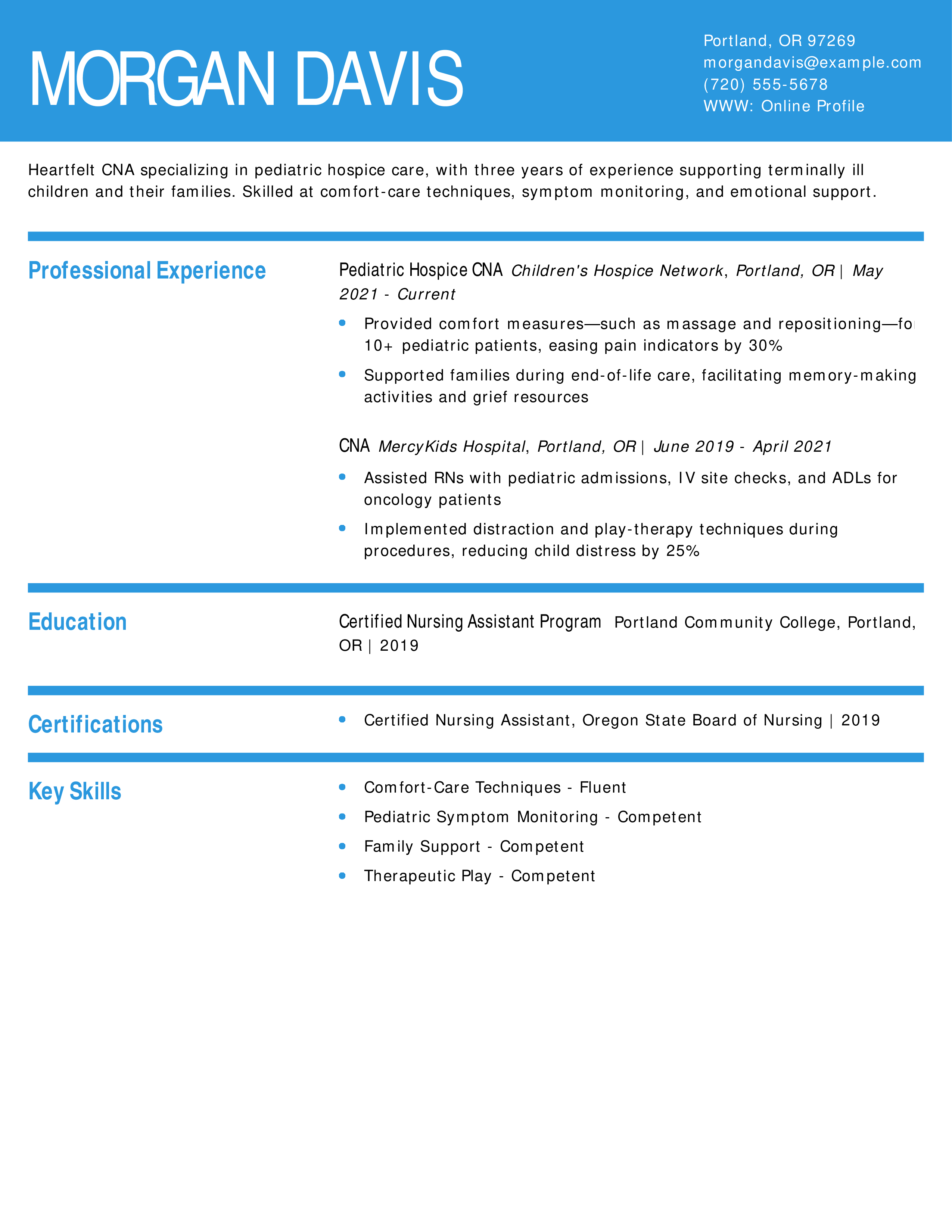
Why this resume is strong:
Morgan’s resume quantifies comfort-care impact, such as 30% pain reduction, and shows specialized pediatric hospice expertise. Family-support activities underscore holistic care.
Key Tips Detail therapeutic outcomes to highlight your palliative-care impact.
For guidance on specialized roles, see Resume Skills. .
CNA Case Manager Resume
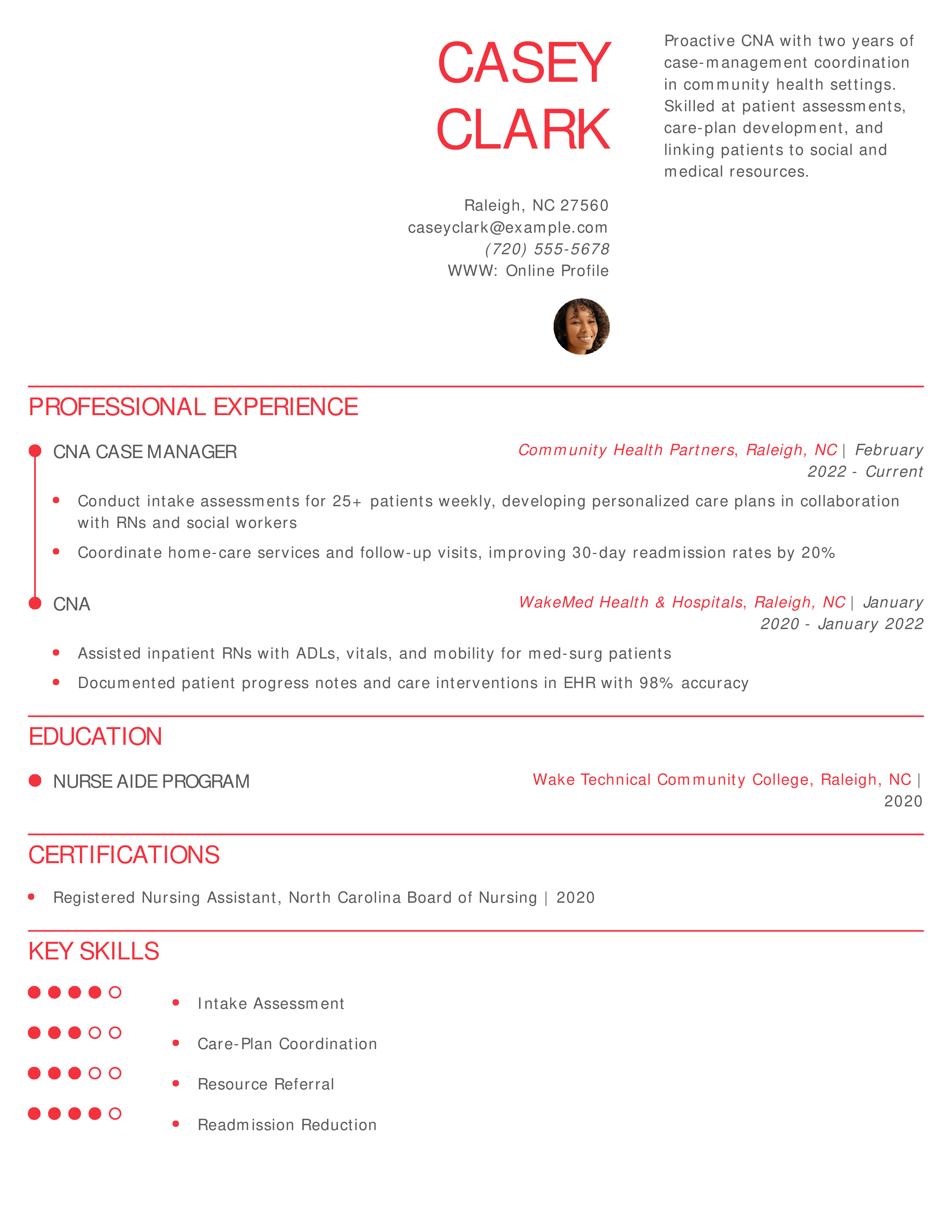
Why this resume is strong:
Casey’s resume demonstrates case-management impact, such as 20% readmission reduction, and highlights collaborative plan development. The blend of clinical care and coordination underscores versatility.
Key Tips Highlight care-coordination results, like readmission reductions, to show system-level impact.
For advice on showcasing hybrid clinical roles, see Best Resume Formats. .
Our templates are crafted by professional resume writers to make creating your resume quick, easy, and effective.
- Professional resume template downloads
- Customized cover letter generation
- AI resume writing support
- Career-building resources and advice
CNA Text-Only Resume Templates and Examples
How To Write a Certified Nursing Assistant Resume
1. Write a brief summary of your certified nursing assistant qualifications
Your resume profile should catch hiring managers’ interest by giving the top reasons they can rely on you for daily patient care. Think about how you excel as a CNA and what you’ve been recognized for. For example, maybe you’ve stood out on your team for actively collaborating with nurse staff. Perhaps you’ve shown high efficiency in balancing patient requests in a large hospital environment. Or you have many years working in facilities like the ones you’re now applying to and offer rare expertise and leadership ability. Cite your top strengths as a CNA in your profile to show managers the impact you’d have on their patient population.
Entry-Level Profile Example
Patient-focused CNA with over three years of experience. Recognized for strong empathy, diligence, and efficiency in helping patients carry out various Activities of Daily Living (ADLs). Naturally curious and committed to gaining and applying new health care expertise.
Senior-Level Profile Example
Lead CNA with over 10 years of experience delivering patient-centered care in high-volume surgical and intensive care units. Equally effective in a leadership or hands-on role. Recognized for treating patients with dignity and compassion while providing emotional support to family members. Adapt readily to new work challenges and conditions.
2. Showcase your certified nursing assistant experience
With the experience section, you can show you’re a great CNA by giving examples of your success in supporting patients’ physical comfort and well-being. For each past CNA job, think of how you contributed to the health care team and how that supported patient outcomes. And when describing your work results, quantify them in terms of a specific number, ranking, or percentage. For instance, did you earn a high satisfaction rating from patients? Or assist a certain number of patients per day or week? Alternatively, did you rank high on your team for efficient or accurate health documentation? Through quantified examples like these, you can help hiring managers envision you as a valued CNA at their care facility.
Entry-Level Professional Experience Example
CNA, UC San Diego Health, San Diego, CA | September 2021 to present
- Deliver compassionate care to patients with acute conditions and injuries
- Ensure optimal patient comfort during bed rest and transport
- Help nursing staff provide wound care and change dressings as needed to improve circulation and reduce risk of infection
- Monitor patients’ pulse, blood pressure, and oxygen saturation level
Highlights:
- Achieved patient satisfaction ratings of 90% to 95%
- Praised for diligent compliance with COVID-19 safety and infection prevention protocols
Mid-Career Professional Experience Example
CNA, Community Medical Center, Scranton, PA | March 2020 to present
- Deliver care to surgical patients in this 300-bed community hospital
- Reduce risk of infection by ensuring compliance with health and safety protocols
- Assist therapeutic exercises during rehab to improve patients’ range of motion following major orthopedic surgeries
- Provide mouth care to patients on life support, monitor vital signs, and alert registered nurses (RNs) and physicians of changes in patient condition
Highlight:
- Identified opportunities to enhance clinical operations and supported efforts to reduce patient wait times by 15%
3. Include education and certifications relevant to certified nursing assistants
Use the education and certifications sections to show your CNA work has a strong knowledge base. Include basic details on your highest school degree, your CNA education program, and any health care credentials you’ve earned. But also consider adding specific course names or topics you covered as part of your studies. This can be a great way to show knowledge of any areas you’d like to gain more experience in as part of your next CNA job.
Below, you’ll find templates and examples to help you format your education and certification details. Note: optional template areas appear in [brackets].
Education
Template
- Degree or Program Name, School Name, City, ST | [Year]
- [Select Coursework: Topic, Topic]
Example
- Nurse Aide Training Program, Lackawanna College, Scranton, PA | 2017
Certification
Template
- Certification Name, [Awarding Organization] | [Year]
Example
- Registered Nurse Aide, Pennsylvania Nurse Aide Registry
4. List key certified nursing assistant skills and proficiencies
Add a key skills section to show hiring managers the many ways you assist your patients and colleagues. Given the varied nature of most CNA positions, this can be a useful section to develop on your resume. The terms you include here can range from soft skills like collaboration to technical skills like Electronic Health Records (EHR) to patient age groups or demographics. Also, if your CNA work has advanced to include administering medications, you may want to feature those in this section. Ensure any term you include overlaps with your target job. Below are some common keywords for CNA resumes:
| Key Skills and Proficiencies | |
|---|---|
| ADLs | Assistive devices |
| Basic Life Support (BLS) | Basic patient care and hygiene |
| Clinical operations | CPR |
| Cross-functional collaboration | Disease and infection prevention |
| EHR | First aid |
| Health care safety protocols | HIPAA |
| Patient advocacy | Patient and family relations |
| Patient assessment | Patient-centered care |
| Patient mobilization | Phlebotomy |
| Physical examinations | Physician support |
| Task prioritization | Time management |
| Vital signs monitoring | |
How To Pick the Best CNA Resume Template
For CNAs, a clear and straightforward resume template is usually best. Opt for a visual design that lets the hiring manager quickly review your best career details. Select a traditional resume font, and avoid any template with colorful or elaborate design. Also, make sure the template is compatible with applicant tracking systems (ATS) employers use to screen resumes.
Frequently Asked Questions: CNA Resume Examples and Advice
What is the best way to highlight my experience in my CNA CV?-
The best way to highlight your experience in your CNA CV is by emphasizing specific achievements in each role. Use bullet points to make your experience scannable and focus on results-driven accomplishments, such as improving processes or saving costs. Include quantifiable data like percentage increases or revenue growth to reinforce the impact of your work.
What are common action verbs for CNA resumes? -
For CNAs, the best resume verbs pertain to hands-on patient care – for example, “delivered,” “provided,” or “supported.” But there are various others you might use to describe your duties and contributions in this field. The following list can help you find a good mix of action verbs for your CNA resume:
| Action Verbs | |
|---|---|
| Administered | Analyzed |
| Collaborated | Communicated |
| Conducted | Coordinated |
| Created | Delivered |
| Developed | Engaged |
| Enhanced | Evaluated |
| Facilitated | Generated |
| Helped | Identified |
| Implemented | Improved |
| Led | Managed |
| Measured | Monitored |
| Oversaw | Partnered |
| Performed | Prevented |
| Provided | Recorded |
| Repositioned | Resolved |
| Retrieved | Supported |
| Worked with | |
How do you align your resume with a job posting?-
The Bureau of Labor Statistics forecasts that jobs for nursing assistants and orderlies will increase by about 5% between 2021 and 2031. This growth rate is roughly the same as the average for all U.S. vocations.
You can get more interviews in this growing field if you tailor your resume for each job application. For example, if the health care facility is seeking a CNA with a strong collaborative streak, you may want to highlight that aspect of your experience in your profile and experience sections. Detail any success you’ve had working with various RNs, LPNs, hospitalists, and other health care professionals. Or say the facility has many ESL patients. You could highlight your foreign language skills both in your profile and as a separate section farther down the document. With adjustments like these, you can make your resume more relevant to each new job opportunity.
What is the best CNA resume format? -
In nearly all cases, use a Combination (or Hybrid) resume, because it’s simplest for hiring managers to learn about your pertinent skills and experience – it’s also easiest for you to align with your job goals.
With the Combination format, you highlight your most relevant skills and expertise in your experience or work history section, and an intro section. (This combination of work history and intro content is where the format gets its name.) Your resume intro should usually include a profile summary and key skills section, but you may also add a career highlights or awards section. By carefully choosing the details for these sections, you can (a) position yourself for your target job and (b) give hiring managers a clear, quick view of what you offer.
How long should I make my CNA resume?-
A one-page CNA resume is the best option for most candidates, as it ensures clarity and brevity. If you have significant achievements or over 10 years of experience, extending to two pages is fine—but only if the content is tailored and directly supports your application. Focus on impactful accomplishments and key skills that relate to the job.
Include your most recent 10 to 15 years of work experience. Older roles should only appear if they provide unique insights or align closely with the job requirements. Keeping your resume concise and relevant will maximize its impact.
Craft your perfect resume in minutes
Get 2x more interviews with Resume Builder. Access Pro Plan features for a limited time!

To increase your chances of an interview, write and submit a strong cover letter. The key to an effective letter is customizing it based on each job opening. Read our CNA cover letter guide to learn how. For other related examples, see our licensed vocational nurse (LVN) and nursing cover letter guides.
